Paul van Yperen's Blog, page 245
January 31, 2019
Because You're Mine (1952)
Because You're Mine (Alexander Hall, 1952) was Mario Lanza's fourth film. He played a famous opera singer, who falls for his sergeant's sister at boot camp. Although there are parallels with his own life where he served in the army and married his buddy's sister, Lanza did not like the script nor his co-star. The critics did not like the result either but the public made the film a success. Who was right?
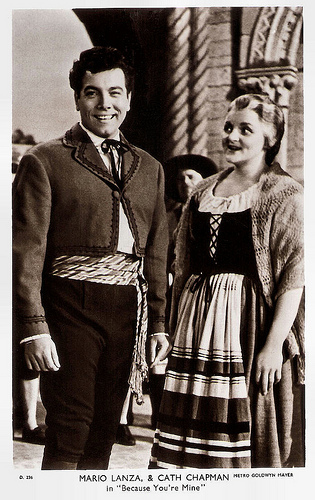
British postcard in the Picturegoer Series, London, no. D 236. Photo: Metro Goldwyn Mayer. Publicity still for Because You're Mine (Alexander Hall, 1952) with Mario Lanza and Cath Chapman.
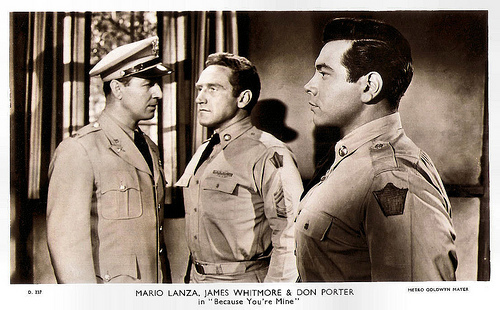
British postcard in the Picturegoer Series, London, no. D 237. Photo: Metro Goldwyn Mayer. Publicity still for Because You're Mine (Alexander Hall, 1952) with Mario Lanza and James Whitmore.
A distracting but intriguing sight
After the triumph of The Great Caruso (1951), Lanza was ready for The Student Prince as his next project. However, MGM wanted to exploit their star's popular image and persuaded him to start on the musical comedy Because You're Mine (Alexander Hall, 1952) with the promise that The Student Prince would be his next project.
With Kathryn Grayson refusing to work with him again, Mario Lanza had a new leading lady, Doretta Morrow, who had just played Tuptim in The King and I on Broadway and would later star in Kismet. The cast of Because You're Mine also included James Whitmore, Paula Corday, Jeff Donnell, and Spring Byington.
Mario Lanza did not like the script of his film, nor his co-star Doretta Morrow, who constantly smoked. He considered Morrow to be unsuitable for her role, because of her limited experience. It would be Morrow only film role. Reportedly Mario Lanza had behaved so outrageously to her during the shooting that after the film was finished, she left Hollywood and never returned.
The plot of Because You're Mine reminds of the stories of Lanza's first two films, That Midnight Kiss and The Toast of New Orleans, although there was a change of characters. Principal photography of the film was interrupted and during the hiatus Lanza put on a huge amount of weight. According to his manager, Lanza then began to lose weight and ended filming at less than 160 pounds.
The temperamental tenor had gained the weight in the vain hope that this would discourage the producers from going ahead with the film. As a result, Lanza's weight varies from 240 pounds to 159 pounds in the film, sometimes even in one scene as when Lanza's character enters a church. In the exterior, shot late in the filming schedule, he looks trim and slim in his military uniform. But, when he steps inside, in a scene filmed earlier, he is noticeably heavier. It is a distracting but intriguing sight. Reportedly, Lanza's costumes had to be remade or altered almost daily.
Dore Schary, MGM studio head at the time, has recounted Lanza's petulant and boorish behaviour on the set, including sexually harassing Doretta Morrow.
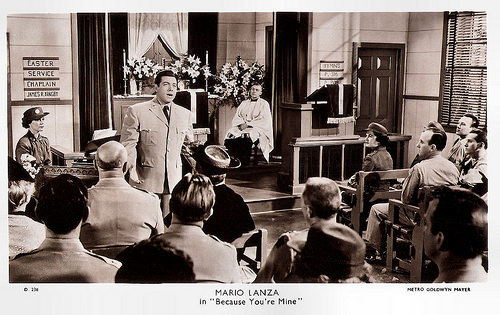
British postcard in the Picturegoer Series, London, no. D 238. Photo: Metro Goldwyn Mayer. Publicity still for Because You're Mine (Alexander Hall, 1952).
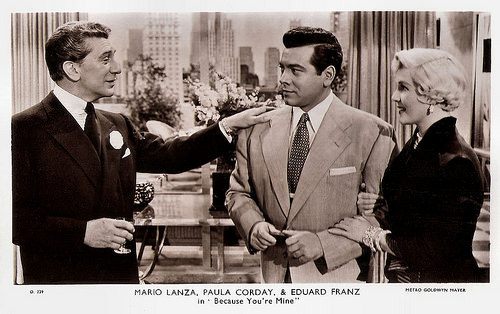
British postcard in the Picturegoer Series, London, no. D 239. Photo: Metro Goldwyn Mayer. Publicity still for Because You're Mine (Alexander Hall, 1952) with Mario Lanza, Paula Corday and Eduard Franz.
A great opera star headed for the army
Mario Lanza plays in Because You're Mine (Alexander Hall, 1952) the famous tenor Renaldo Rossano. The great opera star is only one month away from being too old to be drafted, and is headed for the Army. Even though he earns $5000 a month, he takes it in stride.
Renaldo is recognised right away, but the Captain insists he be treated the same as everyone. Fortunately for him, his commanding officer, Sergeant 'Bat' Batterson (James Whitmore) is a fan. The rest of his platoon as well as the company commander disapproves of Batterson's showing favouritism to Rossano by excusing him from normal training.
Batterson is also trying to promote his sister Bridget (Doretta Morrow) who sings live commercials for the radio. The sergeant arranges for Renaldo and Bridget to meet as a way to help his little sister further her career. Renaldo only does it for selfish reasons, so he will continue to get treated well. But he is surprised to find Bridget beautiful, charming, and a great soprano.
Renaldo falls for her. He is smitten, but Bridget doesn't think she will fit into his lifestyle after Renaldo gets out of the Army. Rossano schemes to have Batterson allow him to go to New York, supposedly to have his manager appraise Brigit's singing voice but in reality allowing him to do a performance.
After realising he's been tricked, the sergeant sets out to make Rossano's military life considerably more difficult. The general's wife (Spring Byington) who also is a big fan helps out. The film ends with Renaldo and Bridget singing a duet, the title song 'Because You're Mine.'
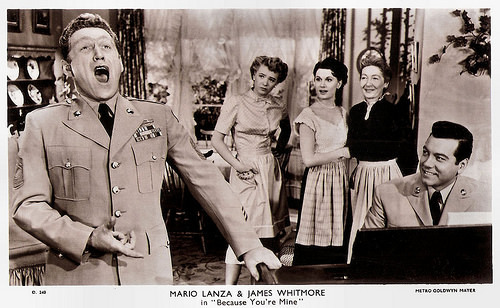
British postcard in the Picturegoer Series, London, no. D 240. Photo: Metro Goldwyn Mayer. Publicity still for Because You're Mine (Alexander Hall, 1952) with Mario Lanza and James Whitmore.
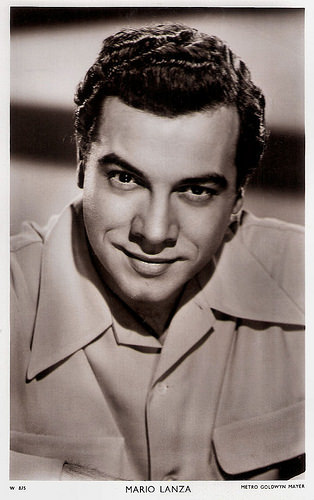
British postcard in the Picturegoer Series, London, no. W 875. Photo: Metro Goldwyn Mayer.
A must for opera and Lanza fans
The title song 'Because You're Mine', a duet with the despised Doretta Morrow, became one of Lanza's greatest hits. Written by Sammy Cahn and Nicholas Brodszky, it became Lanza's third and final million-selling effort. The song was nominated for an Oscar, but lost to Do Not Forsake Me, Oh My Darlin' from High Noon.
According to MGM records, the film earned $2,267,000 in the US and Canada and $2,304,000 elsewhere, resulting in profits of $735,000. Because You're Mine was the fifth most popular film at the British box office in 1953,and was chosen as the 1952 Royal Command film in U.K. However the film was much criticised on its release as artistically a step backwards for the celebrated tenor. Coming after The Great Caruso it suffered badly in comparison with that considerable achievement.
At the premiere, Bosley Crowther of The New York Times voiced a common opinion, finding the film's plot "banal" and observing, "It's really Mario Lanza's singing that should and will attract attention to this technicolored film. (...) Mr. Lanza delivering a song is a great deal more entertaining than Mr. Lanza delivering a gag, especially the sort here written for him by Karl Tunberg and Leonard Spigelgass.It is not that Mr. Lanza's delivery or the gags are really poor or the story in which they cozily nestle is in any way hard to take. It is just that the lot of them—the story, the gags and Mr. Lanza's aplomb in playing what is supposed to be funny—are a little bit obvious and banal. "
But how is the film seen by viewers today? Derek McGovern at IMDb : "Actually, this is a fun movie. It lacks the polish of That Midnight Kiss and the sheer high spirits of Toast of New Orleans, but vocally at least this film has more going for it than either of those two movies. Highlights include a definitive Granada (in a key one and a half tones higher than the Three Tenors have ever dared to attempt!), a moving Lord's Prayer and several pleasing operatic and popular selections."
At IMDb , Blanche2 adds: "Broadway star Doretta Morrow is perky, and while not as pretty as Grayson, sings beautifully. Lanza was not very nice to her - that's putting it mildly - but apparently eventually apologized. (...) the film is pleasant enough, and he sings like a dream, doing a segment from 'Il Trovatore', the 'Addio' from 'Rigoletto', the end of 'Cavalleria Rusticana', the 'Our Father', the title song, 'Because You're Mine', and a very impressive 'Granada'. Not only does he impress with his glorious high notes, he does some very lyrical and soft singing as well. (...) Very pleasant and a must for opera and Lanza fans."
And finally Craig Butler at AllMovie : "Here's the long and the short of it: if you like Mario Lanza, you will like Because You're Mine, and if you don't like Mario Lanza, there's no point in subjecting yourself to Because."
Sources: Bosley Crowther (The New York Times), Craig Butler (AllMovie), Derek McGovern (IMDb), Blanche-2 (IMDb), Wikipedia and IMDb.

British postcard in the Picturegoer Series, London, no. D 236. Photo: Metro Goldwyn Mayer. Publicity still for Because You're Mine (Alexander Hall, 1952) with Mario Lanza and Cath Chapman.

British postcard in the Picturegoer Series, London, no. D 237. Photo: Metro Goldwyn Mayer. Publicity still for Because You're Mine (Alexander Hall, 1952) with Mario Lanza and James Whitmore.
A distracting but intriguing sight
After the triumph of The Great Caruso (1951), Lanza was ready for The Student Prince as his next project. However, MGM wanted to exploit their star's popular image and persuaded him to start on the musical comedy Because You're Mine (Alexander Hall, 1952) with the promise that The Student Prince would be his next project.
With Kathryn Grayson refusing to work with him again, Mario Lanza had a new leading lady, Doretta Morrow, who had just played Tuptim in The King and I on Broadway and would later star in Kismet. The cast of Because You're Mine also included James Whitmore, Paula Corday, Jeff Donnell, and Spring Byington.
Mario Lanza did not like the script of his film, nor his co-star Doretta Morrow, who constantly smoked. He considered Morrow to be unsuitable for her role, because of her limited experience. It would be Morrow only film role. Reportedly Mario Lanza had behaved so outrageously to her during the shooting that after the film was finished, she left Hollywood and never returned.
The plot of Because You're Mine reminds of the stories of Lanza's first two films, That Midnight Kiss and The Toast of New Orleans, although there was a change of characters. Principal photography of the film was interrupted and during the hiatus Lanza put on a huge amount of weight. According to his manager, Lanza then began to lose weight and ended filming at less than 160 pounds.
The temperamental tenor had gained the weight in the vain hope that this would discourage the producers from going ahead with the film. As a result, Lanza's weight varies from 240 pounds to 159 pounds in the film, sometimes even in one scene as when Lanza's character enters a church. In the exterior, shot late in the filming schedule, he looks trim and slim in his military uniform. But, when he steps inside, in a scene filmed earlier, he is noticeably heavier. It is a distracting but intriguing sight. Reportedly, Lanza's costumes had to be remade or altered almost daily.
Dore Schary, MGM studio head at the time, has recounted Lanza's petulant and boorish behaviour on the set, including sexually harassing Doretta Morrow.

British postcard in the Picturegoer Series, London, no. D 238. Photo: Metro Goldwyn Mayer. Publicity still for Because You're Mine (Alexander Hall, 1952).

British postcard in the Picturegoer Series, London, no. D 239. Photo: Metro Goldwyn Mayer. Publicity still for Because You're Mine (Alexander Hall, 1952) with Mario Lanza, Paula Corday and Eduard Franz.
A great opera star headed for the army
Mario Lanza plays in Because You're Mine (Alexander Hall, 1952) the famous tenor Renaldo Rossano. The great opera star is only one month away from being too old to be drafted, and is headed for the Army. Even though he earns $5000 a month, he takes it in stride.
Renaldo is recognised right away, but the Captain insists he be treated the same as everyone. Fortunately for him, his commanding officer, Sergeant 'Bat' Batterson (James Whitmore) is a fan. The rest of his platoon as well as the company commander disapproves of Batterson's showing favouritism to Rossano by excusing him from normal training.
Batterson is also trying to promote his sister Bridget (Doretta Morrow) who sings live commercials for the radio. The sergeant arranges for Renaldo and Bridget to meet as a way to help his little sister further her career. Renaldo only does it for selfish reasons, so he will continue to get treated well. But he is surprised to find Bridget beautiful, charming, and a great soprano.
Renaldo falls for her. He is smitten, but Bridget doesn't think she will fit into his lifestyle after Renaldo gets out of the Army. Rossano schemes to have Batterson allow him to go to New York, supposedly to have his manager appraise Brigit's singing voice but in reality allowing him to do a performance.
After realising he's been tricked, the sergeant sets out to make Rossano's military life considerably more difficult. The general's wife (Spring Byington) who also is a big fan helps out. The film ends with Renaldo and Bridget singing a duet, the title song 'Because You're Mine.'

British postcard in the Picturegoer Series, London, no. D 240. Photo: Metro Goldwyn Mayer. Publicity still for Because You're Mine (Alexander Hall, 1952) with Mario Lanza and James Whitmore.

British postcard in the Picturegoer Series, London, no. W 875. Photo: Metro Goldwyn Mayer.
A must for opera and Lanza fans
The title song 'Because You're Mine', a duet with the despised Doretta Morrow, became one of Lanza's greatest hits. Written by Sammy Cahn and Nicholas Brodszky, it became Lanza's third and final million-selling effort. The song was nominated for an Oscar, but lost to Do Not Forsake Me, Oh My Darlin' from High Noon.
According to MGM records, the film earned $2,267,000 in the US and Canada and $2,304,000 elsewhere, resulting in profits of $735,000. Because You're Mine was the fifth most popular film at the British box office in 1953,and was chosen as the 1952 Royal Command film in U.K. However the film was much criticised on its release as artistically a step backwards for the celebrated tenor. Coming after The Great Caruso it suffered badly in comparison with that considerable achievement.
At the premiere, Bosley Crowther of The New York Times voiced a common opinion, finding the film's plot "banal" and observing, "It's really Mario Lanza's singing that should and will attract attention to this technicolored film. (...) Mr. Lanza delivering a song is a great deal more entertaining than Mr. Lanza delivering a gag, especially the sort here written for him by Karl Tunberg and Leonard Spigelgass.It is not that Mr. Lanza's delivery or the gags are really poor or the story in which they cozily nestle is in any way hard to take. It is just that the lot of them—the story, the gags and Mr. Lanza's aplomb in playing what is supposed to be funny—are a little bit obvious and banal. "
But how is the film seen by viewers today? Derek McGovern at IMDb : "Actually, this is a fun movie. It lacks the polish of That Midnight Kiss and the sheer high spirits of Toast of New Orleans, but vocally at least this film has more going for it than either of those two movies. Highlights include a definitive Granada (in a key one and a half tones higher than the Three Tenors have ever dared to attempt!), a moving Lord's Prayer and several pleasing operatic and popular selections."
At IMDb , Blanche2 adds: "Broadway star Doretta Morrow is perky, and while not as pretty as Grayson, sings beautifully. Lanza was not very nice to her - that's putting it mildly - but apparently eventually apologized. (...) the film is pleasant enough, and he sings like a dream, doing a segment from 'Il Trovatore', the 'Addio' from 'Rigoletto', the end of 'Cavalleria Rusticana', the 'Our Father', the title song, 'Because You're Mine', and a very impressive 'Granada'. Not only does he impress with his glorious high notes, he does some very lyrical and soft singing as well. (...) Very pleasant and a must for opera and Lanza fans."
And finally Craig Butler at AllMovie : "Here's the long and the short of it: if you like Mario Lanza, you will like Because You're Mine, and if you don't like Mario Lanza, there's no point in subjecting yourself to Because."
Sources: Bosley Crowther (The New York Times), Craig Butler (AllMovie), Derek McGovern (IMDb), Blanche-2 (IMDb), Wikipedia and IMDb.
Published on January 31, 2019 22:00
January 30, 2019
Dorothy Lamour
American actress and singer Dorothy Lamour (1914-1996) is best remembered for appearing in the Road to... comedies, starring Bing Crosby and Bob Hope. During World War II, Lamour was among the most popular pin-up girls among American servicemen.
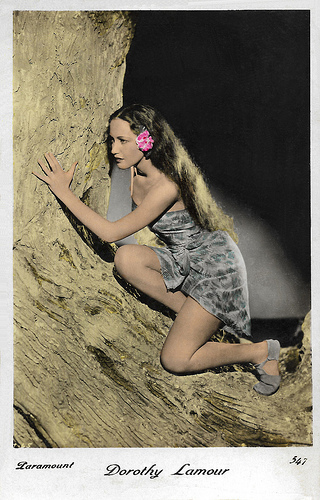
British postcard, London, no. 547. Photo: Paramount. Publicity still for The Jungle Princess (Wilhelm Thiele, 1936).
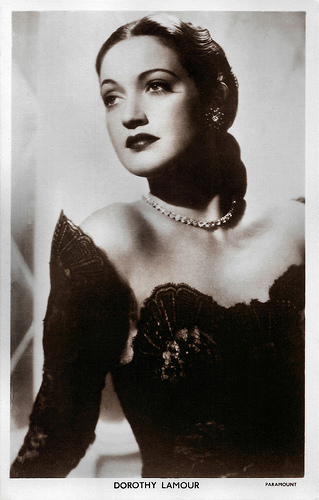
British postcard in the Picturegoer Series, London, no. B. 11. Photo: Paramount.
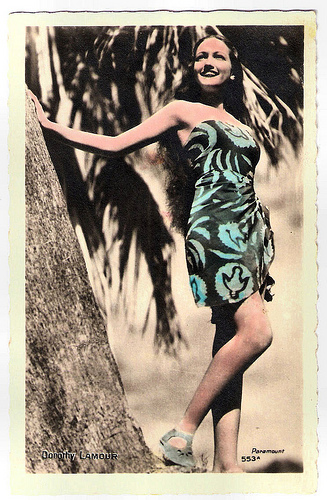
French postcard by E.C., Rueil-Malmaison, no. 553A. Photo: Paramount. Publicity still for Her Jungle Love (George Archainbaud, 1938).
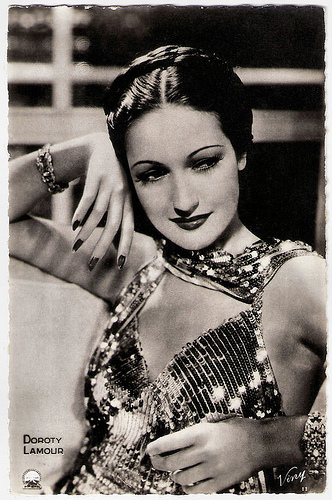
French postcard by Viny, no. 11. Photo: Paramount.
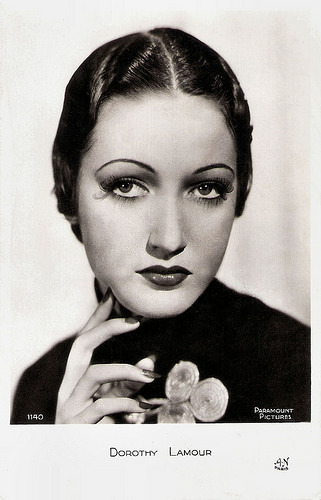
French postcard by A.N., Paris, no. 1140. Photo: Paramount Pictures.
The Sarong Queen
Dorothy Lamour was born Mary Leta Dorothy Slaton in 1914 in New Orleans. She was the daughter of Carmen Louise and John Watson Slaton, both of whom were waiters. Her parents' marriage lasted only a few years. Her mother married for the second time to Clarence Lambour, whose surname Dorothy later adopted and modified as her stage name.
Lamour quit school at age 14. After taking a business course, she worked as a secretary to support herself and her mother. As a teenager, beautiful Dorothy turned heads with her long dark hair. She won the beauty contest Miss New Orleans in 1931 and she headed to Chicago to find work as a singer.
For a time, she worked in Chicago as an elevator operator in a department store before going on to become a singer for the big band Herbie Kaye, who became her first husband in 1935. In addition to the band, Dorothy also sang on a Chicago radio program.
In 1936, she moved to Hollywood where she signed with Paramount Pictures. Around that time, Carmen married her third husband, Ollie Castleberry, and the family lived in Los Angeles. Dorothy appeared as jungle native Ulah in The Jungle Princess (William Thiele, 1936) who was raised with a pet tiger among the tropical natives. Ray Milland co-starred as the man from civilisation who woos and wins her. The scene where Milland is trying to teach her the word kiss is a classic, and the film was a money-maker. The film also gave her a hit song 'Moonlight and Shadows'.
Her wrap-around sarong, designed by Edith Head, marked the beginning of her image as the 'Sarong Queen'. Lamour played similar parts in The Hurricane (John Ford, 1937) with Jon Hall, Her Jungle Love (George Archainbaud, 1938) again with Ray Milland , Typhoon (Louis King, 1940), Beyond the Blue Horizon (Alfred Santell, 1942) and her final big-screen sarong feature, Donovan's Reef (John Ford, 1963), starring John Wayne. Although Lamour actually only wore a sarong in six of her 59 pictures, it defined her career.
In 1940, Lamour made her first Road to... comedy film, Road to Singapore (Victor Schertzinger, 1940). The film was a solid hit and response to the team was enthusiastic. Lamour, Hope and Crosby reunited in Road to Zanzibar (Victor Schertzinger, 1941) which was even more successful and eventually led to a series of seven pictures.
The Road to.. films were a combination of adventure, slapstick, as-libbing, romance, and music, and they regularly placed among the top moneymaking films during the 1940s. While the films centred more on Bob Hope and Bing Crosby, Lamour held her own as their 'straight man', and sang some of her most popular songs. She later said: "I was the happiest and highest-paid straight woman in the business."
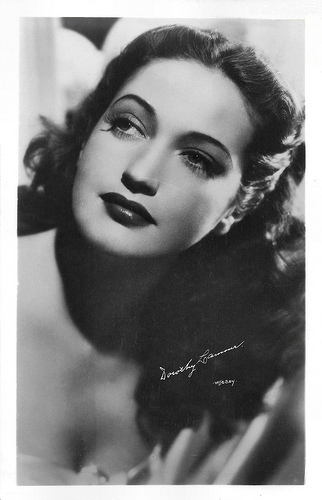
British postcard. Photo: W.J.C. Bay.
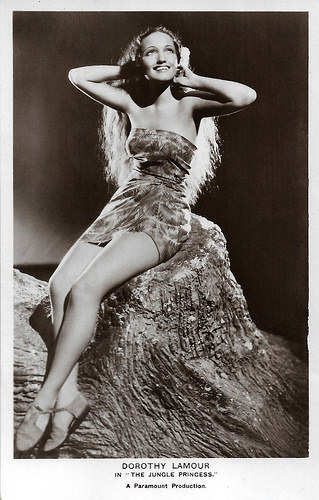
British Real Photograph postcard, London, no. FS 116. Photo: Paramount. Publicity still for The Jungle Princess (Wilhelm Thiele, 1936).
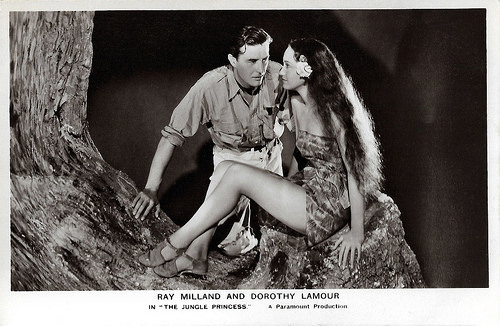
British Real Photograph postcard, London, no. FS 117 Photo: Paramount. Publicity still of Ray Milland and Dorothy Lamour in The Jungle Princess (Wilhelm Thiele, 1936).
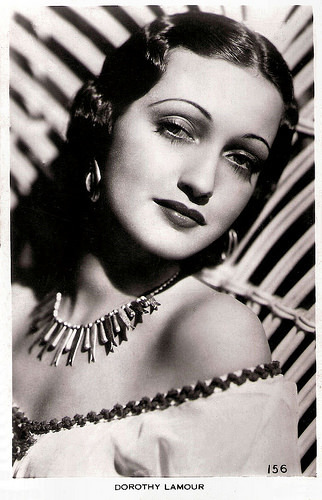
British Real Photograph postcard, no. 156.
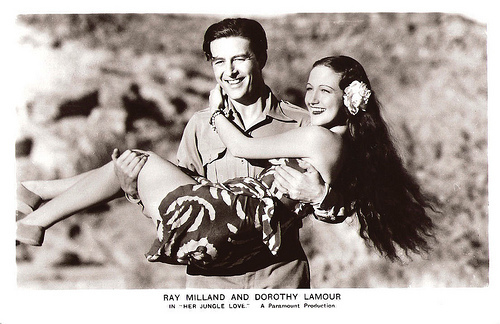
British Real Photograph postcard, London, no. FS 179. Photo: Paramount. Ray Milland and Dorothy Lamour in Her Jungle Love (George Archainbaud, 1938).
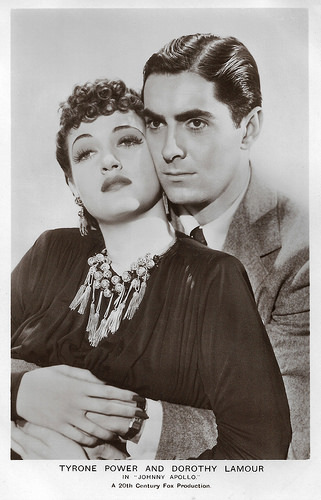
British postcard in the Film Partners Series, London, no. P 325. Photo: 20th Century Fox. Publicity still for Johnny Apollo (Henry Hathaway, 1940) with Tyrone Power.
My Side of the Road
During World War II, Dorothy Lamour was among the most popular pinup girls among American servicemen, along with Betty Grable, Rita Hayworth , Lana Turner, and Veronica Lake. During World War II, she toured the country, selling in excess of $300 million worth of war bonds.
Lamour could show great range in both comic and dramatic roles. Among her serious films were Disputed Passage (Frank Borzage, 1939) with Akim Tamiroff, the gangster film Johnny Apollo (Henry Hathaway, 1940) starring Tyrone Power, and A Medal for Benny (Irving Pichel, 1945), based on a story by John Steinbeck, co-starring Arturo de Córdova.
In 1947, she was in three big hits in a row: My Favorite Brunette (Elliott Nugent, 1947), a comedy with Bob Hope; Wild Harvest (Tay Garnett, 1947), a melodrama with Alan Ladd; and Road to Rio (Norman McLeod, 1947). She also sang a duet with Ladd in Variety Girl (George Marshall, 1947). Then she left Paramount. Later she was in one more big hit, Cecil B. De Mille's circus epic The Greatest Show on Earth (1952).
The Road to... series essentially ended with the release of Road to Bali (Hal Walker, 1952). By that time, Lamour's screen career began to wane and she focused on stage and television work. In 1961, Crosby and Hope teamed up for one more, The Road to Hong Kong (Norman Panama, 1962), but Joan Collins played the female lead. Lamour made a brief appearance and sang a song near the end of that film. A final Road to... picture, Road to the Fountain of Youth was in the works in 1977, until Bing Crosby's sudden death.
In the 1970s, Lamour revived her nightclub act and, in 1980, she released her autobiography 'My Side of the Road'. She only made ten films between 1951 and 1987. The last one was Creepshow 2 (Michael Gornick, 1987), appearing with George Kennedy as an ageing couple who are killed during a robbery. In 1987, she made her final onscreen appearance in the TV series Murder she wrote with Angela Lansbury .
Dorotthy Lamour's first marriage was to orchestra leader Herbie Kay whose big band she sang with. The two married in 1935 and divorced in 1939. Lamour married her second husband, William Ross Howard III, in 1943. They had two sons and remained married until Howard's death in 1978.
Dorothy Lamour died at her home in Los Angeles in 1996. She was 81. Her stepson William Ross 'Bill, Jr.' Howard IV was born in 1933. Her son John Ridgely 'Ridge' Howard was born in 1946. Her son Richard Thomson 'Tommy' Howard was born in 1949.
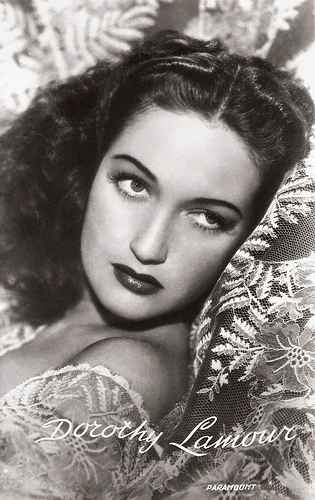
Dutch postcard, no. 3205. Photo: Paramount.
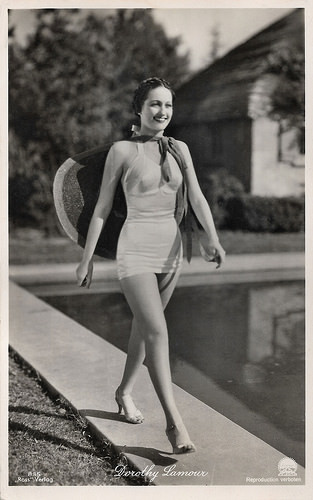
German postcard by Ross Verlag, no. 835. Photo: Paramount.
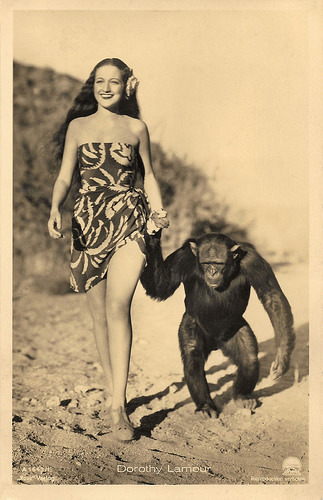
German postcard by Ross Verlag, no. A 1643/1, 1937-1938. Photo: Paramount. Publicity still for The Jungle Princess (Wilhelm Thiele, 1936).
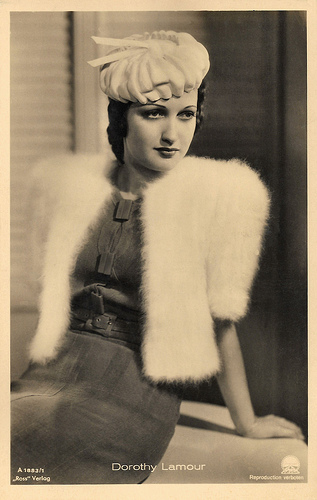
German postcard by Ross Verlag, no. A 1883/1, 1937-1938. Photo: Paramount.
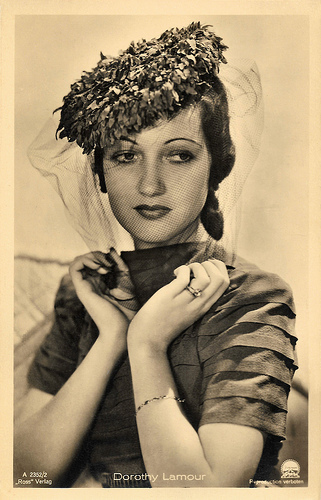
German postcard by Ross Verlag, no. A 2352/2, 1939-1940. Photo: Paramount.
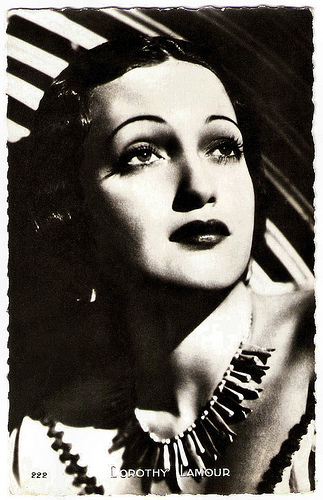
French postcard by Editions P.I., Paris, no. 222.
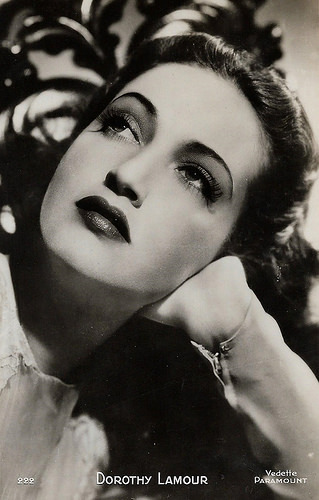
French postcard, no. 222. Photo: Paramount.
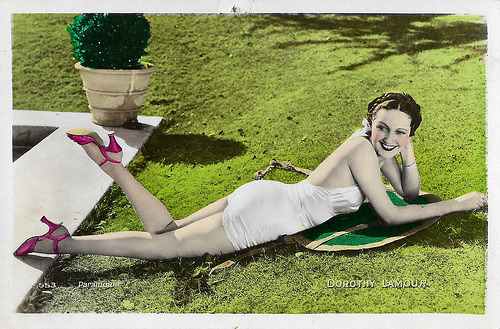
French postcard, no. 553. Photo: Paramount.
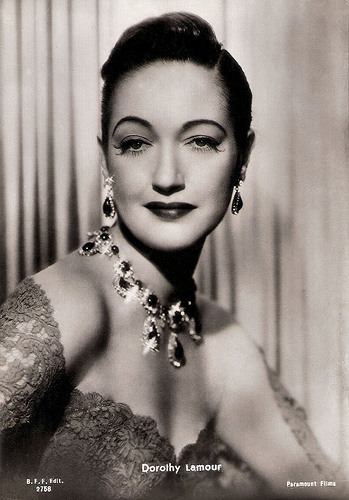
Italian postcard by B.F.F. Edit, no. 2758. Photo: Paramount Films.
Sources: (IMDb), (IMDb), Wikipedia and .

British postcard, London, no. 547. Photo: Paramount. Publicity still for The Jungle Princess (Wilhelm Thiele, 1936).

British postcard in the Picturegoer Series, London, no. B. 11. Photo: Paramount.

French postcard by E.C., Rueil-Malmaison, no. 553A. Photo: Paramount. Publicity still for Her Jungle Love (George Archainbaud, 1938).

French postcard by Viny, no. 11. Photo: Paramount.

French postcard by A.N., Paris, no. 1140. Photo: Paramount Pictures.
The Sarong Queen
Dorothy Lamour was born Mary Leta Dorothy Slaton in 1914 in New Orleans. She was the daughter of Carmen Louise and John Watson Slaton, both of whom were waiters. Her parents' marriage lasted only a few years. Her mother married for the second time to Clarence Lambour, whose surname Dorothy later adopted and modified as her stage name.
Lamour quit school at age 14. After taking a business course, she worked as a secretary to support herself and her mother. As a teenager, beautiful Dorothy turned heads with her long dark hair. She won the beauty contest Miss New Orleans in 1931 and she headed to Chicago to find work as a singer.
For a time, she worked in Chicago as an elevator operator in a department store before going on to become a singer for the big band Herbie Kaye, who became her first husband in 1935. In addition to the band, Dorothy also sang on a Chicago radio program.
In 1936, she moved to Hollywood where she signed with Paramount Pictures. Around that time, Carmen married her third husband, Ollie Castleberry, and the family lived in Los Angeles. Dorothy appeared as jungle native Ulah in The Jungle Princess (William Thiele, 1936) who was raised with a pet tiger among the tropical natives. Ray Milland co-starred as the man from civilisation who woos and wins her. The scene where Milland is trying to teach her the word kiss is a classic, and the film was a money-maker. The film also gave her a hit song 'Moonlight and Shadows'.
Her wrap-around sarong, designed by Edith Head, marked the beginning of her image as the 'Sarong Queen'. Lamour played similar parts in The Hurricane (John Ford, 1937) with Jon Hall, Her Jungle Love (George Archainbaud, 1938) again with Ray Milland , Typhoon (Louis King, 1940), Beyond the Blue Horizon (Alfred Santell, 1942) and her final big-screen sarong feature, Donovan's Reef (John Ford, 1963), starring John Wayne. Although Lamour actually only wore a sarong in six of her 59 pictures, it defined her career.
In 1940, Lamour made her first Road to... comedy film, Road to Singapore (Victor Schertzinger, 1940). The film was a solid hit and response to the team was enthusiastic. Lamour, Hope and Crosby reunited in Road to Zanzibar (Victor Schertzinger, 1941) which was even more successful and eventually led to a series of seven pictures.
The Road to.. films were a combination of adventure, slapstick, as-libbing, romance, and music, and they regularly placed among the top moneymaking films during the 1940s. While the films centred more on Bob Hope and Bing Crosby, Lamour held her own as their 'straight man', and sang some of her most popular songs. She later said: "I was the happiest and highest-paid straight woman in the business."

British postcard. Photo: W.J.C. Bay.

British Real Photograph postcard, London, no. FS 116. Photo: Paramount. Publicity still for The Jungle Princess (Wilhelm Thiele, 1936).

British Real Photograph postcard, London, no. FS 117 Photo: Paramount. Publicity still of Ray Milland and Dorothy Lamour in The Jungle Princess (Wilhelm Thiele, 1936).

British Real Photograph postcard, no. 156.

British Real Photograph postcard, London, no. FS 179. Photo: Paramount. Ray Milland and Dorothy Lamour in Her Jungle Love (George Archainbaud, 1938).

British postcard in the Film Partners Series, London, no. P 325. Photo: 20th Century Fox. Publicity still for Johnny Apollo (Henry Hathaway, 1940) with Tyrone Power.
My Side of the Road
During World War II, Dorothy Lamour was among the most popular pinup girls among American servicemen, along with Betty Grable, Rita Hayworth , Lana Turner, and Veronica Lake. During World War II, she toured the country, selling in excess of $300 million worth of war bonds.
Lamour could show great range in both comic and dramatic roles. Among her serious films were Disputed Passage (Frank Borzage, 1939) with Akim Tamiroff, the gangster film Johnny Apollo (Henry Hathaway, 1940) starring Tyrone Power, and A Medal for Benny (Irving Pichel, 1945), based on a story by John Steinbeck, co-starring Arturo de Córdova.
In 1947, she was in three big hits in a row: My Favorite Brunette (Elliott Nugent, 1947), a comedy with Bob Hope; Wild Harvest (Tay Garnett, 1947), a melodrama with Alan Ladd; and Road to Rio (Norman McLeod, 1947). She also sang a duet with Ladd in Variety Girl (George Marshall, 1947). Then she left Paramount. Later she was in one more big hit, Cecil B. De Mille's circus epic The Greatest Show on Earth (1952).
The Road to... series essentially ended with the release of Road to Bali (Hal Walker, 1952). By that time, Lamour's screen career began to wane and she focused on stage and television work. In 1961, Crosby and Hope teamed up for one more, The Road to Hong Kong (Norman Panama, 1962), but Joan Collins played the female lead. Lamour made a brief appearance and sang a song near the end of that film. A final Road to... picture, Road to the Fountain of Youth was in the works in 1977, until Bing Crosby's sudden death.
In the 1970s, Lamour revived her nightclub act and, in 1980, she released her autobiography 'My Side of the Road'. She only made ten films between 1951 and 1987. The last one was Creepshow 2 (Michael Gornick, 1987), appearing with George Kennedy as an ageing couple who are killed during a robbery. In 1987, she made her final onscreen appearance in the TV series Murder she wrote with Angela Lansbury .
Dorotthy Lamour's first marriage was to orchestra leader Herbie Kay whose big band she sang with. The two married in 1935 and divorced in 1939. Lamour married her second husband, William Ross Howard III, in 1943. They had two sons and remained married until Howard's death in 1978.
Dorothy Lamour died at her home in Los Angeles in 1996. She was 81. Her stepson William Ross 'Bill, Jr.' Howard IV was born in 1933. Her son John Ridgely 'Ridge' Howard was born in 1946. Her son Richard Thomson 'Tommy' Howard was born in 1949.

Dutch postcard, no. 3205. Photo: Paramount.

German postcard by Ross Verlag, no. 835. Photo: Paramount.

German postcard by Ross Verlag, no. A 1643/1, 1937-1938. Photo: Paramount. Publicity still for The Jungle Princess (Wilhelm Thiele, 1936).

German postcard by Ross Verlag, no. A 1883/1, 1937-1938. Photo: Paramount.

German postcard by Ross Verlag, no. A 2352/2, 1939-1940. Photo: Paramount.

French postcard by Editions P.I., Paris, no. 222.

French postcard, no. 222. Photo: Paramount.

French postcard, no. 553. Photo: Paramount.

Italian postcard by B.F.F. Edit, no. 2758. Photo: Paramount Films.
Sources: (IMDb), (IMDb), Wikipedia and .
Published on January 30, 2019 22:00
January 29, 2019
Das Deutsche Lied (1928)
Das Deutsche Lied/The German song (Karl Pindl, 1928) was a silent film produced by the Döring film company in Hannover, under guidance of the Deutsche Sängerbund (DSB), the singers union. The film had its premiere in Vienna, Austria, at the 10th German Sängerbundesfest (Singers Union Festival) between 19 and 23 July 1928.The German premiere took place on 6 November 1928 at the Berlin Titania-Palast. Das Deutsche Lied honored the social status and historical significance of German songwriting. The film was scripted by Ferdinand Schneider and William Torge, while Karl Pindl directed the film. Sets were by Artur Günther, cinematography by Hugo Urban and August Lutz.
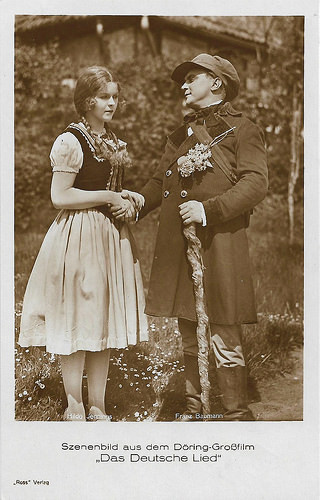
German postcard by Ross Verlag. Photo: Döring Film. Publicity still for Das Deutsche Lied (Karl Pindl, 1928) with Franz Baumann as Konrad Forster and Hilda Jennings as Hilde Lenz, singing the song 'Muss i' denn, muss i' denn...'.
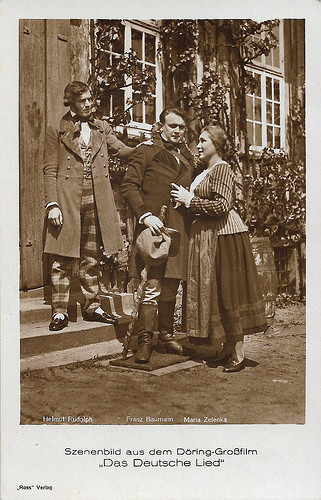
German postcard by Ross Verlag. Photo: Döring Film. Publicity still for Das Deutsche Lied (Karl Pindl, 1928) with Helmut Rudolph, Maria Zelenka, and Franz Baumann perform the song 'Nun leb' wohl, du kleine Gasse!' Konrad Forster (Hetmut Rudolph) says goodbye to his parents Johannes and Katharina.
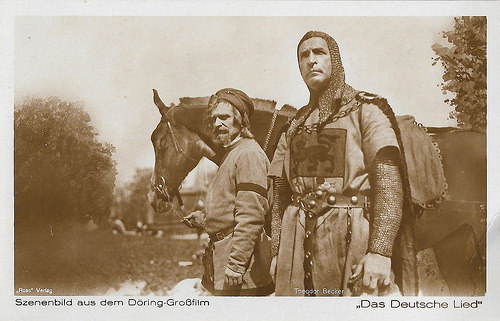
German postcard by Ross Verlag. Photo: Döring Film. Publicity still for Das Deutsche Lied (Karl Pindl, 1928) with Theodor Becker as Graf Otto von Meran, in the historical part of the film.
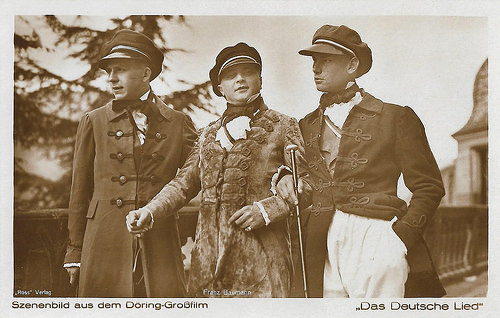
German postcard by Ross Verlag. Photo: Döring Film. Publicity still for Das Deutsche Lied (Karl Pindl, 1928) with Franz Baumann performing the song 'Alt Heidelberg, du feine!'
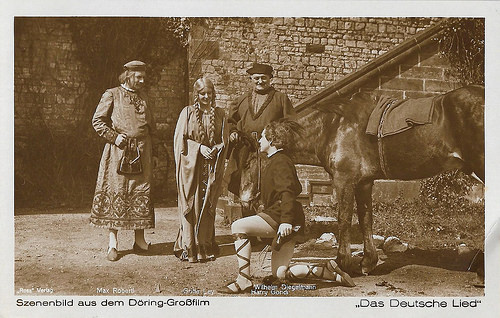
German postcard by Ross Verlag. Photo: Döring Film. Publicity still for Das Deutsche Lied (Karl Pindl, 1928) with Max Roberti as Graf Kuno von Eisack, Gritta Ley as his daughter Irmgard, Harry Gondi as Walther von der Vogelweide, and Wilhelm Diegelmann as Burgvogt, in the historical part of the film.
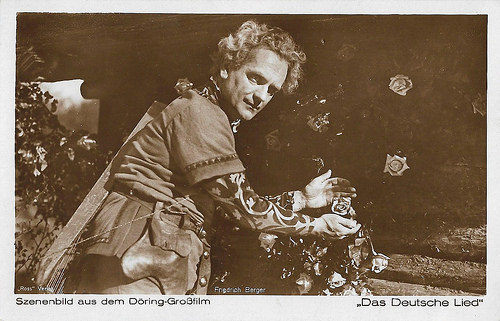
German postcard by Ross Verlag. Photo: Döring Film. Publicity still for Das Deutsche Lied (Karl Pindl, 1928) with Friedrich Berger as the 'Minnesänger' Reinmar von Hagenau, teacher of Walther von der Vogelweide, in the historical part of the film.
English Wikipedia : "Reinmar von Hagenau (died before 1210) was a German minnesinger of the twelfth century, surnamed in the MSS. der Alte (the old) to distinguish him from later poets of that name. [...] most of Reinmar's poems show more elegance of form than beauty of sentiment. In a society, however, where form was valued more than contents, such poetry was bound to meet with favour."
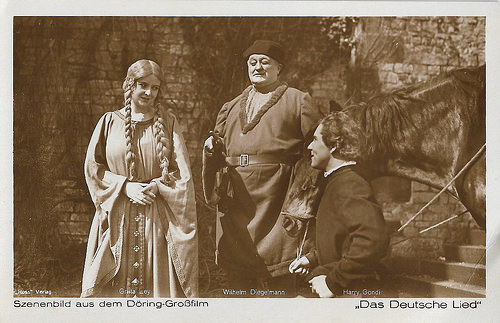
German postcard by Ross Verlag. Photo: Döring Film. Publicity still for Das Deutsche Lied (Karl Pindl, 1928) with Gritta Ley as Irmgard, Harry Gondi as Walther von der Vogelweide, and Wilhelm Diegelmann as Burgvogt, in the historical part of the film.
English Wikipedia : "Walther von der Vogelweide (c. 1170 – c. 1230) was a Minnesänger, who composed and performed love-songs and political songs ("Sprüche") in Middle High German. Walther has been described as greatest German lyrical poet before Goethe. His hundred or so love-songs are widely regarded as the pinnacle of 'Minnesang', the medieval German love lyric, and his innovations breathed new life into the tradition of courtly love. He is also the first political poet writing in German, with a considerable body of encomium, satire, invective, and moralising."
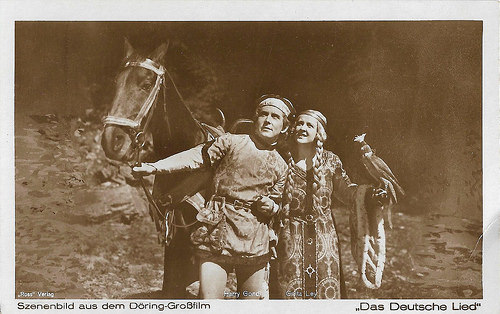
German postcard by Ross Verlag. Photo: Döring Film. Publicity still for Das Deutsche Lied (Karl Pindl, 1928) with Gritta Ley as Irmgard and Harry Gondi as Walther von der Vogelweide, in the historical part of the film.

German postcard by Ross Verlag. Photo: Döring Film. Publicity still for Das Deutsche Lied (Karl Pindl, 1928) with Theodor Becker as Graf Otto von Meran (Otto, Count of Merania) and Frida Richard as Frau Hilde (mother of Walther von der Vogelweide), in the historical part of the film.
Source: Wikipedia and IMDb.

German postcard by Ross Verlag. Photo: Döring Film. Publicity still for Das Deutsche Lied (Karl Pindl, 1928) with Franz Baumann as Konrad Forster and Hilda Jennings as Hilde Lenz, singing the song 'Muss i' denn, muss i' denn...'.

German postcard by Ross Verlag. Photo: Döring Film. Publicity still for Das Deutsche Lied (Karl Pindl, 1928) with Helmut Rudolph, Maria Zelenka, and Franz Baumann perform the song 'Nun leb' wohl, du kleine Gasse!' Konrad Forster (Hetmut Rudolph) says goodbye to his parents Johannes and Katharina.

German postcard by Ross Verlag. Photo: Döring Film. Publicity still for Das Deutsche Lied (Karl Pindl, 1928) with Theodor Becker as Graf Otto von Meran, in the historical part of the film.

German postcard by Ross Verlag. Photo: Döring Film. Publicity still for Das Deutsche Lied (Karl Pindl, 1928) with Franz Baumann performing the song 'Alt Heidelberg, du feine!'

German postcard by Ross Verlag. Photo: Döring Film. Publicity still for Das Deutsche Lied (Karl Pindl, 1928) with Max Roberti as Graf Kuno von Eisack, Gritta Ley as his daughter Irmgard, Harry Gondi as Walther von der Vogelweide, and Wilhelm Diegelmann as Burgvogt, in the historical part of the film.

German postcard by Ross Verlag. Photo: Döring Film. Publicity still for Das Deutsche Lied (Karl Pindl, 1928) with Friedrich Berger as the 'Minnesänger' Reinmar von Hagenau, teacher of Walther von der Vogelweide, in the historical part of the film.
English Wikipedia : "Reinmar von Hagenau (died before 1210) was a German minnesinger of the twelfth century, surnamed in the MSS. der Alte (the old) to distinguish him from later poets of that name. [...] most of Reinmar's poems show more elegance of form than beauty of sentiment. In a society, however, where form was valued more than contents, such poetry was bound to meet with favour."

German postcard by Ross Verlag. Photo: Döring Film. Publicity still for Das Deutsche Lied (Karl Pindl, 1928) with Gritta Ley as Irmgard, Harry Gondi as Walther von der Vogelweide, and Wilhelm Diegelmann as Burgvogt, in the historical part of the film.
English Wikipedia : "Walther von der Vogelweide (c. 1170 – c. 1230) was a Minnesänger, who composed and performed love-songs and political songs ("Sprüche") in Middle High German. Walther has been described as greatest German lyrical poet before Goethe. His hundred or so love-songs are widely regarded as the pinnacle of 'Minnesang', the medieval German love lyric, and his innovations breathed new life into the tradition of courtly love. He is also the first political poet writing in German, with a considerable body of encomium, satire, invective, and moralising."

German postcard by Ross Verlag. Photo: Döring Film. Publicity still for Das Deutsche Lied (Karl Pindl, 1928) with Gritta Ley as Irmgard and Harry Gondi as Walther von der Vogelweide, in the historical part of the film.

German postcard by Ross Verlag. Photo: Döring Film. Publicity still for Das Deutsche Lied (Karl Pindl, 1928) with Theodor Becker as Graf Otto von Meran (Otto, Count of Merania) and Frida Richard as Frau Hilde (mother of Walther von der Vogelweide), in the historical part of the film.
Source: Wikipedia and IMDb.
Published on January 29, 2019 22:00
January 28, 2019
Kampf um die Scholle (1925)
Kampf um die Scholle/Struggle for the Soil (Erich Waschneck, 1925) was produced by the Cutural Department of the Universum Film AG (UFA). This was also announced on the series of Ross Verlag cards, issued to promote the film. The German production featured a cast with diverse stars like Polish-born Mary Parker, Hungarian matinee idol Oscar Marion, Ferdinand von Alten and Margarete Schön, known as Kriemhild from Fritz Lang's Die Nibelungen (1924).
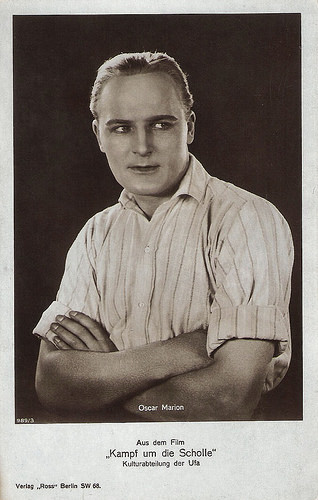
Oscar Marion . German postcard by Ross Verlag, no. 989/3, 1925-1926. Photo: Ufa. Publicity still for Kampf um die Scholle/Struggle for the Soil (Erich Waschneck, 1925).
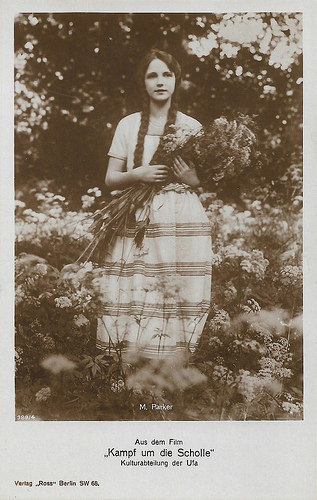
German postcard by Ross Verlag, no. 989/4, 1925-1926. Photo: Ufa. Publicity still for Kampf um die Scholle/Struggle for the Soil (Erich Waschneck, 1925), with Mary Parker as Luise, daughter of the estate manager Karl Marten.
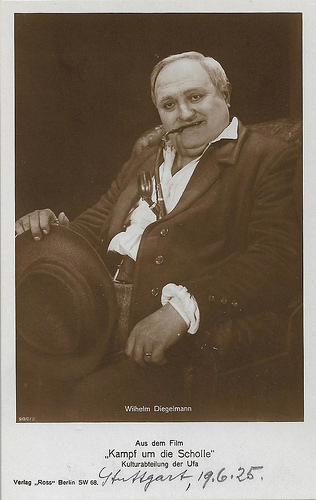
German postcard by Ross Verlag, no. 989/3. This postcard is dated: Stuttgart, 19 June 1925. Photo: Ufa. Publicity still for Kampf um die Scholle/Struggle for the Soil (Erich Waschneck, 1925) with Wilhelm Diegelman as Uncle Uhl.
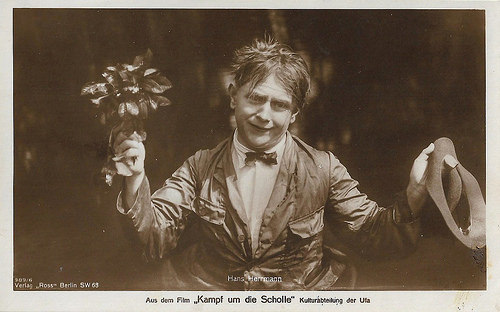
German postcard by Ross Verlag, no. 989/6. Photo: Ufa. Publicity still for Kampf um die Scholle/Struggle for the Soil (Erich Waschneck, 1925) with Hans Hermann.
Much effort, passion and hard work
Kampf um die Scholle/Struggle for the Soil (Erich Waschneck, 1925) was based on the novel Der Kampf um die Scholle : eine Geschichte aus Masuren by author Fritz Skowronnek. The subtitle refers to Mazury, then a part of Prussia, now a region in Poland, where the story is situated.
In Kampf um die Scholle, Freiherr (manor owner) von Wulfshagen (Gustav Oberg) has built- with much effort, passion and hard work - his manor into a magnificent estate. After the death of his father, son Axel (Ferdinand von Alten) takes over the management of the estate, but under his leadership, the property deteriorates rapidly.
Axel is not interested in agriculture, he is a lighthearted sportsman who does not care about the well-intentioned advice of the old inspector Karl (Otto Kronburger), but accumulates more and more debts.
Not even his younger brother Franz ( Oscar Marion ), who has studied agriculture and diligently builds his own estate, manages to speak to his conscience. Through his stubbornness, Axel spoils his relationships with all those who mean well with him.
As the sneaky property dealer Grosskopp (Victor Schwanneke) learns of Axel's money shortages, he scents an easy prey. He presents himself as an understanding friend and grants Axel repeatedly loans, albeit with the aim of bringing the valuable goods sooner or later into his possession.
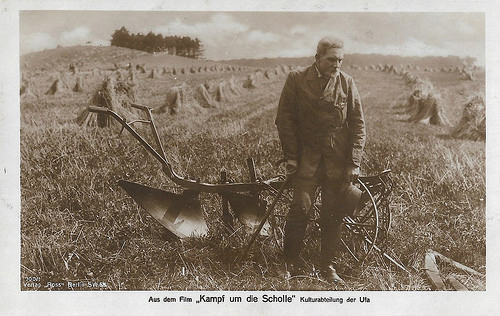
German postcard by Ross Verlag, no. 700/1. Photo: Ufa. Publicity still for Kampf um die Scholle/Struggle for the Soil (Erich Waschneck, 1925) with Gustav Oberg as Freiherr von Wulfshagen.
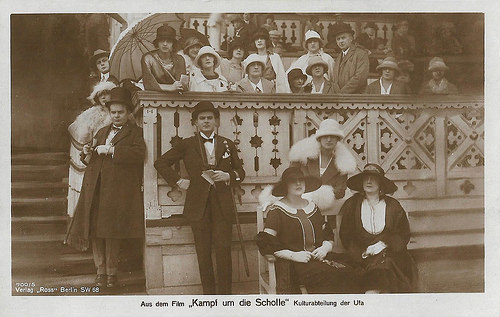
German postcard by Ross Verlag, no. 700/5. Photo: Ufa. Publicity still for Kampf um die Scholle/Struggle for the Soil (Erich Waschneck, 1925) with in the middle Ferdinand von Alten as Axel von Wulffshagen at the races, squandering his father's money.
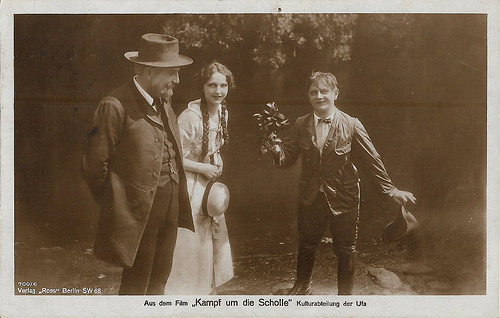
German postcard by Ross Verlag, no. 700/6. Photo: Ufa. Publicity still for Kampf um die Scholle/Struggle for the Soil (Erich Waschneck, 1925) with Otto Kronburger as Karl Merten, Mary Parker as his daughter Luise, and Hans Hermann (Schaufuss) as Gutseleve Fritz Quirlitz.
Atmospheric lighting and sublime facial close-ups
Kampf um die Scholle/Struggle for the Soil (1925) was produced by the 'Kulturabteilung' (cultural department) of the UFA, and was a typical Heimatfilm. The Kulturabteilung was known as the documentary unit of UFA, but also produced the Kulturfilm Wege zu Kraft und Schönheit/Ways to Strength and Beauty (Wilhelm Prager, Nicholas Kaufmann, 1925).
Erich Waschneck made his directorial debut with this film. Waschneck had started his film career as a still photographer and later as camera assistant to the famous cinematographer Fritz Arno Wagner. Since 1921, he had been a cinematographer for such films as Ein Glas Wasser/One Glass of Water (Ludwig Berger, 1923).
Kampf um die Scholle was scripted by Willy Rath and director Erich Waschneck, and they based it on a novel by Fritz Skowronnek. (IMDb and Wikipedia both mistakenly mention Fritz Reuter as the author. Skowronnek also wrote under the pseudonyms Fritz Bernhard and Hans Windeck). The set design was done by Botho Höfer, Bernhard Schwidewski, and Hans Minzloff.
Cinematographer was Friedl Behn-Grund, who was only 18 at the time. He had started his film career as a child actor in 1919. In 1923, he started to work as an assistant cameraman to Erich Wasneck and learned all aspects of the craft swiftly. Kampf um die Scholle was his debut as a cinematographer.
Hans-Michael Bock writes in The Concise Cinegraph about him: "Renowned for his atmospheric lighting, sublime facial close-ups and ability to adapt to the requirements of individual directors, Behn-Grund remained a sought-after cinematographer from the 1920s through the 1970s."
The exteriors of Kampf um die Scholle were shot between 1924 and January 1925 at Lensahn (Holstein). The film premiered on 27 January 1925, at the Ufa-Palast am Zoo in Berlin.
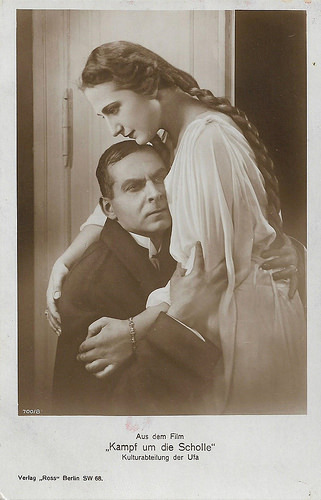
German postcard by Ross Verlag, no. 700/8. Photo: Ufa. Publicity still for Kampf um die Scholle/Struggle for the Soil (Erich Waschneck, 1925) with Ferdinand von Alten and Margarete Schön .
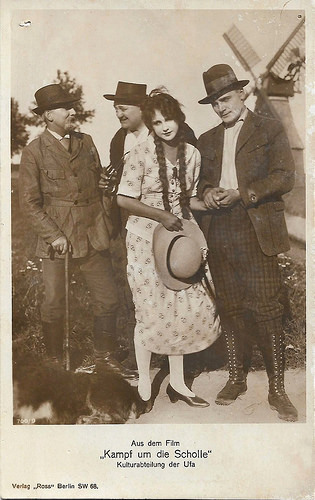
German postcard by Ross Verlag, no. 700/9. Photo: Ufa. Publicity still for Kampf um die Scholle/Struggle for the Soil (Erich Waschneck, 1925) with Oscar Marion as Franz, the younger brother of estate owner Axel, who has an affair with Luise ( Mary Parker ), daughter of the estate manager Karl Marten (left; Otto Kronburger). The man behind Parker is Wilhelm Diegelmann, who plays Uncle Uhl.
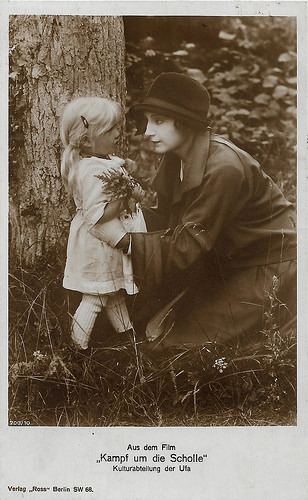
German postcard by Ross Verlag, no. 700/10. Photo: Ufa. Publicity still for Kampf um die Scholle/Struggle for the Soil (Erich Waschneck, 1925) with Margarete Schön as Frieda, wife of Axel.
Sources: Hans-Michael Bock (The Concise Cinegraph), Filmportal.de (German), Wikipedia and IMDb.

Oscar Marion . German postcard by Ross Verlag, no. 989/3, 1925-1926. Photo: Ufa. Publicity still for Kampf um die Scholle/Struggle for the Soil (Erich Waschneck, 1925).

German postcard by Ross Verlag, no. 989/4, 1925-1926. Photo: Ufa. Publicity still for Kampf um die Scholle/Struggle for the Soil (Erich Waschneck, 1925), with Mary Parker as Luise, daughter of the estate manager Karl Marten.

German postcard by Ross Verlag, no. 989/3. This postcard is dated: Stuttgart, 19 June 1925. Photo: Ufa. Publicity still for Kampf um die Scholle/Struggle for the Soil (Erich Waschneck, 1925) with Wilhelm Diegelman as Uncle Uhl.

German postcard by Ross Verlag, no. 989/6. Photo: Ufa. Publicity still for Kampf um die Scholle/Struggle for the Soil (Erich Waschneck, 1925) with Hans Hermann.
Much effort, passion and hard work
Kampf um die Scholle/Struggle for the Soil (Erich Waschneck, 1925) was based on the novel Der Kampf um die Scholle : eine Geschichte aus Masuren by author Fritz Skowronnek. The subtitle refers to Mazury, then a part of Prussia, now a region in Poland, where the story is situated.
In Kampf um die Scholle, Freiherr (manor owner) von Wulfshagen (Gustav Oberg) has built- with much effort, passion and hard work - his manor into a magnificent estate. After the death of his father, son Axel (Ferdinand von Alten) takes over the management of the estate, but under his leadership, the property deteriorates rapidly.
Axel is not interested in agriculture, he is a lighthearted sportsman who does not care about the well-intentioned advice of the old inspector Karl (Otto Kronburger), but accumulates more and more debts.
Not even his younger brother Franz ( Oscar Marion ), who has studied agriculture and diligently builds his own estate, manages to speak to his conscience. Through his stubbornness, Axel spoils his relationships with all those who mean well with him.
As the sneaky property dealer Grosskopp (Victor Schwanneke) learns of Axel's money shortages, he scents an easy prey. He presents himself as an understanding friend and grants Axel repeatedly loans, albeit with the aim of bringing the valuable goods sooner or later into his possession.

German postcard by Ross Verlag, no. 700/1. Photo: Ufa. Publicity still for Kampf um die Scholle/Struggle for the Soil (Erich Waschneck, 1925) with Gustav Oberg as Freiherr von Wulfshagen.

German postcard by Ross Verlag, no. 700/5. Photo: Ufa. Publicity still for Kampf um die Scholle/Struggle for the Soil (Erich Waschneck, 1925) with in the middle Ferdinand von Alten as Axel von Wulffshagen at the races, squandering his father's money.

German postcard by Ross Verlag, no. 700/6. Photo: Ufa. Publicity still for Kampf um die Scholle/Struggle for the Soil (Erich Waschneck, 1925) with Otto Kronburger as Karl Merten, Mary Parker as his daughter Luise, and Hans Hermann (Schaufuss) as Gutseleve Fritz Quirlitz.
Atmospheric lighting and sublime facial close-ups
Kampf um die Scholle/Struggle for the Soil (1925) was produced by the 'Kulturabteilung' (cultural department) of the UFA, and was a typical Heimatfilm. The Kulturabteilung was known as the documentary unit of UFA, but also produced the Kulturfilm Wege zu Kraft und Schönheit/Ways to Strength and Beauty (Wilhelm Prager, Nicholas Kaufmann, 1925).
Erich Waschneck made his directorial debut with this film. Waschneck had started his film career as a still photographer and later as camera assistant to the famous cinematographer Fritz Arno Wagner. Since 1921, he had been a cinematographer for such films as Ein Glas Wasser/One Glass of Water (Ludwig Berger, 1923).
Kampf um die Scholle was scripted by Willy Rath and director Erich Waschneck, and they based it on a novel by Fritz Skowronnek. (IMDb and Wikipedia both mistakenly mention Fritz Reuter as the author. Skowronnek also wrote under the pseudonyms Fritz Bernhard and Hans Windeck). The set design was done by Botho Höfer, Bernhard Schwidewski, and Hans Minzloff.
Cinematographer was Friedl Behn-Grund, who was only 18 at the time. He had started his film career as a child actor in 1919. In 1923, he started to work as an assistant cameraman to Erich Wasneck and learned all aspects of the craft swiftly. Kampf um die Scholle was his debut as a cinematographer.
Hans-Michael Bock writes in The Concise Cinegraph about him: "Renowned for his atmospheric lighting, sublime facial close-ups and ability to adapt to the requirements of individual directors, Behn-Grund remained a sought-after cinematographer from the 1920s through the 1970s."
The exteriors of Kampf um die Scholle were shot between 1924 and January 1925 at Lensahn (Holstein). The film premiered on 27 January 1925, at the Ufa-Palast am Zoo in Berlin.

German postcard by Ross Verlag, no. 700/8. Photo: Ufa. Publicity still for Kampf um die Scholle/Struggle for the Soil (Erich Waschneck, 1925) with Ferdinand von Alten and Margarete Schön .

German postcard by Ross Verlag, no. 700/9. Photo: Ufa. Publicity still for Kampf um die Scholle/Struggle for the Soil (Erich Waschneck, 1925) with Oscar Marion as Franz, the younger brother of estate owner Axel, who has an affair with Luise ( Mary Parker ), daughter of the estate manager Karl Marten (left; Otto Kronburger). The man behind Parker is Wilhelm Diegelmann, who plays Uncle Uhl.

German postcard by Ross Verlag, no. 700/10. Photo: Ufa. Publicity still for Kampf um die Scholle/Struggle for the Soil (Erich Waschneck, 1925) with Margarete Schön as Frieda, wife of Axel.
Sources: Hans-Michael Bock (The Concise Cinegraph), Filmportal.de (German), Wikipedia and IMDb.
Published on January 28, 2019 22:00
January 27, 2019
Heidegretel (1918)
Hella Moja played the title role in the German silent melodrama Heide-Gretel (Otto Rippert, 1918). The film was produced by Erich Pommer for the Decla-Filmgellschaft. Rotophoto published a series of five sepia postcards in the Film-Sterne series of the film.
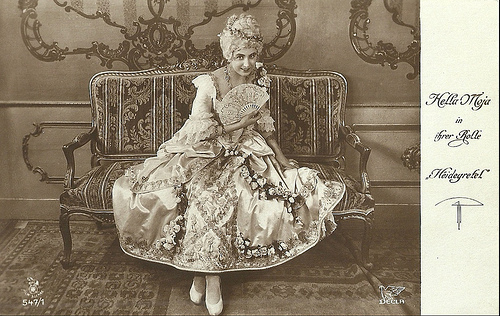
German postcard in the Film-Sterne series by Rotophot, no. 547/1. Photo: Decla. Publicity still of Hella Moja in Heide-Gretel (Otto Rippert, 1918).
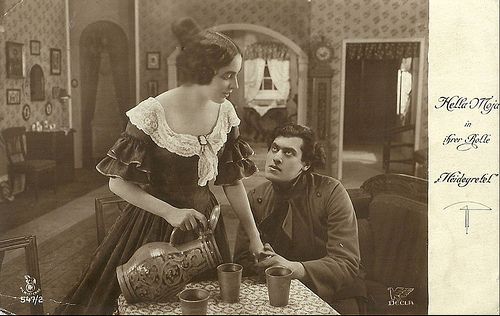
German postcard in the Film-Sterne series by Rotophot, no. 547/2. Photo: Decla. Publicity still of Hella Moja in Heide-Gretel (Otto Rippert, 1918). The man is probably Max Ruhbeck.
A Nightmare in the Snow
Hella Moja was one of the most popular stars of the German cinema during the First World War. In 1918, she even founded her own production company. In February 1918, her film Heide-Gretel, directed by Otto Rippert, premiered at the Berlin Marmorhaus cinema. Heide-Gretel was still produced by the Decla-Filmgellschaft, lead by Erich Pommer, who would later produce such classics as Das Cabinet des Dr. Caligari (Robert Wiene, 1920) and Metropolis (Fritz Lang, 1925). The cinematography was done by Carl Hoffmann.
The script by Carl Schneider tells the story of Heide-Gretel ( Hella Moja ), who has hard times in the inn 'Zum Mooskrug'. The landlord, her foster-father, beats her for every little mistake. When he wants to beat her again because she accidentally dropped glasses, two men protectively stand before her: Konrad and the ballet master Pankratius.
Heide-Gretel does not want to stay in this place any longer and runs out into the snow-covered forest, crying bitterly. Exhausted and desperate, the girl falls into a deep sleep despite the cold. Then she starts to dream...
In her dream, Konrad and Pankratius are by her side. She is led into the house of the ballet master, where the chamberlain of the sovereign has just arrived to discuss the upcoming ballet production. When Gretel starts to sing, the Chamberlain is delighted and leads her to the castle of the Prince. In her dream, the Prince suddenly falls in love with Gretel and wants to make her his wife, but she only agrees on condition he takes her protector Konrad to his court. Out of love for her, the Prince accepts Gretel's request.
When Konrad is at court, the Prince surprises his future wife on the morning of the wedding in his arms. The Prince has the rival thrown into a dungeon, but he soon frees him again at Gretel's request. Then she murders the Prince in her dream, whereupon she is arrested. To avoid the executioner, Konrad brings her poison so that she can die by her own hand. Konrad joins her into her death. From this nightmare, Gretel no longer awakens. People will find her frozen in the snow the next morning.
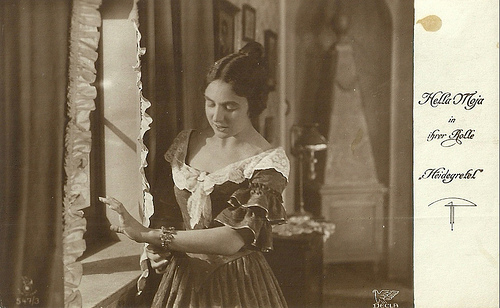
German postcard in the Film-Sterne series by Rotophot, no. 547/3. Photo: Decla. Publicity still of Hella Moja in Heide-Gretel (Otto Rippert, 1918).
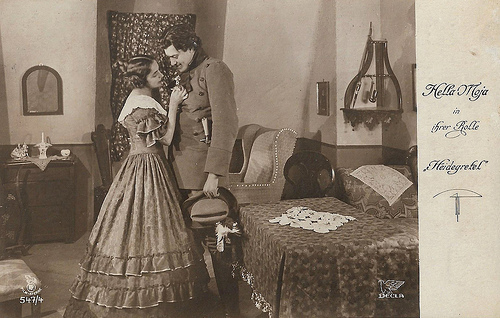
German postcard in the Film-Sterne series by Rotophot, no. 547/4. Photo: Decla. Publicity still of Hella Moja in Heide-Gretel (Otto Rippert, 1918). The man is probably Max Ruhbeck.
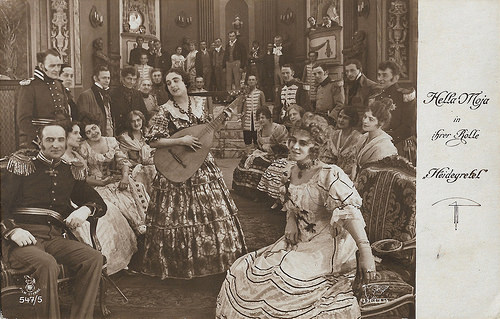
German postcard in the Film-Sterne series by Rotophot, no. 547/5. Photo: Decla. Publicity still of Hella Moja in Heide-Gretel (Otto Rippert, 1918). The man left could be Leopold von Ledebur, the Prince in the film.
Source: Wikipedia (German), Filmportal.de, and IMDb.

German postcard in the Film-Sterne series by Rotophot, no. 547/1. Photo: Decla. Publicity still of Hella Moja in Heide-Gretel (Otto Rippert, 1918).

German postcard in the Film-Sterne series by Rotophot, no. 547/2. Photo: Decla. Publicity still of Hella Moja in Heide-Gretel (Otto Rippert, 1918). The man is probably Max Ruhbeck.
A Nightmare in the Snow
Hella Moja was one of the most popular stars of the German cinema during the First World War. In 1918, she even founded her own production company. In February 1918, her film Heide-Gretel, directed by Otto Rippert, premiered at the Berlin Marmorhaus cinema. Heide-Gretel was still produced by the Decla-Filmgellschaft, lead by Erich Pommer, who would later produce such classics as Das Cabinet des Dr. Caligari (Robert Wiene, 1920) and Metropolis (Fritz Lang, 1925). The cinematography was done by Carl Hoffmann.
The script by Carl Schneider tells the story of Heide-Gretel ( Hella Moja ), who has hard times in the inn 'Zum Mooskrug'. The landlord, her foster-father, beats her for every little mistake. When he wants to beat her again because she accidentally dropped glasses, two men protectively stand before her: Konrad and the ballet master Pankratius.
Heide-Gretel does not want to stay in this place any longer and runs out into the snow-covered forest, crying bitterly. Exhausted and desperate, the girl falls into a deep sleep despite the cold. Then she starts to dream...
In her dream, Konrad and Pankratius are by her side. She is led into the house of the ballet master, where the chamberlain of the sovereign has just arrived to discuss the upcoming ballet production. When Gretel starts to sing, the Chamberlain is delighted and leads her to the castle of the Prince. In her dream, the Prince suddenly falls in love with Gretel and wants to make her his wife, but she only agrees on condition he takes her protector Konrad to his court. Out of love for her, the Prince accepts Gretel's request.
When Konrad is at court, the Prince surprises his future wife on the morning of the wedding in his arms. The Prince has the rival thrown into a dungeon, but he soon frees him again at Gretel's request. Then she murders the Prince in her dream, whereupon she is arrested. To avoid the executioner, Konrad brings her poison so that she can die by her own hand. Konrad joins her into her death. From this nightmare, Gretel no longer awakens. People will find her frozen in the snow the next morning.

German postcard in the Film-Sterne series by Rotophot, no. 547/3. Photo: Decla. Publicity still of Hella Moja in Heide-Gretel (Otto Rippert, 1918).

German postcard in the Film-Sterne series by Rotophot, no. 547/4. Photo: Decla. Publicity still of Hella Moja in Heide-Gretel (Otto Rippert, 1918). The man is probably Max Ruhbeck.

German postcard in the Film-Sterne series by Rotophot, no. 547/5. Photo: Decla. Publicity still of Hella Moja in Heide-Gretel (Otto Rippert, 1918). The man left could be Leopold von Ledebur, the Prince in the film.
Source: Wikipedia (German), Filmportal.de, and IMDb.
Published on January 27, 2019 22:00
January 26, 2019
Charles Bronson
American actor Charles Bronson (1921-2003) was the archetypal screen tough guy with weather beaten features, often cast in the role of police officer, gunfighter, or convict. He was a man of few words but much action in hits like Machine-Gun Kelly (1958), The Magnificent Seven (1960) and The Dirty Dozen (1967). But our favourite is the iconic Spaghetti Western C'era una volta il West/Once Upon a Time in the West (1968). In the USA, Bronson suddenly became a star at the age of 53, after his role as the vengeful urban vigilante in Death Wish (1974). He had long-term collaborations with film directors Michael Winner and J. Lee Thompson, and appeared in fifteen films alongside his second wife, Jill Ireland.
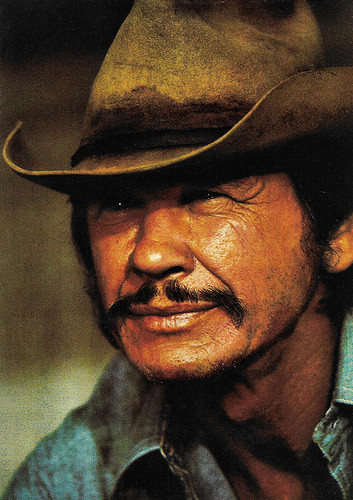
Italian postcard by Edizioni Beatrice d'Este, no. 20025. Photo: publicity still for Breakout (Tom Gries, 1975).
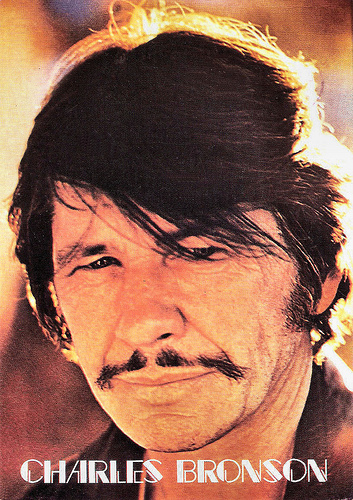
French postcard by Delta-Productions, Saint-Jean-de-Vedas, no. R53.
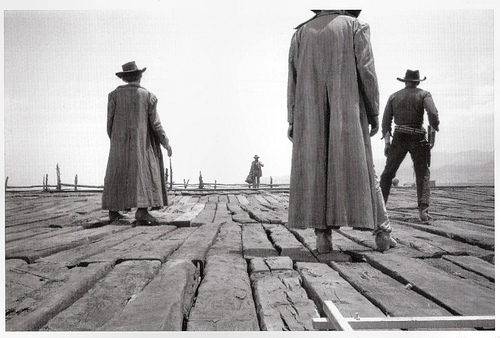
Italian postcard by Cineteca Bologna, 2007. Photo: A. Novi / Cineteca di Bologna. Publicity still for C'era una volta il West/Once Upon a Time in the West (Sergio Leone, 1968).
The mute and morbid assistant to Vincent Price
Charles Bronson was born Charles Dennis Buchinsky, in Ehrenfeld, Pennsylvania, in 1921. He was the 11th of 15 children of struggling Roman Catholic parents. His mother, Mary (Valinsky), was born in Pennsylvania, to Lithuanian parents, and his father, Walter Buchinsky, was a Lithuanian immigrant coal miner. The family had Lipka Tatar roots (Lipka Tatars were a group of Tatars who originally settled in the Grand Duchy of Lithuania at the beginning of the 14th century).
His father died when Charles was 10. He learned to speak English when he was a teenager; before that, he spoke Lithuanian and Russian. Charles completed high school, and at 16 he followed his brothers into the mines to support the family. He was paid $1 for each ton of coal that he mined and volunteered for perilous jobs because the pay was better.
Charles was drafted into the army in 1943 and assigned to the Air Corps. At first he was a truck driver, but was later trained as a bomber tail gunner and in 1945, he was assigned to a B-29. He flew 25 missions and received, among other decorations, a Purple Heart for wounds incurred in battle. After his return from the war, Bronson used the GI Bill to study art.
Bronson worked at many odd jobs. While working as a set designer for a Philadelphia theatre troupe, Bronson played a few small roles and almost immediately switched his allegiance from the production end of theatre to acting. In New York he shared an apartment with Jack Klugman while both were aspiring to play on the stage. In 1949, he moved to California, where he signed up for acting lessons at the Pasadena Playhouse. One of his teachers was impressed with the young man and recommended him to director Henry Hathaway, resulting in Bronson making his film debut in You're in the Navy Now (Henry Hathaway, 1951), with Gary Cooper.
Charles Buchinsky appeared on screen often early in his career, though usually uncredited. However, he made an impact on audiences as Igor, the mute and morbid assistant to deranged sculptor Vincent Price in the 3-D thriller House of Wax (Andre de Toth, 1953). In 1954, in the midst of the McCarthy 'Red Scare', he changed his stage name at the suggestion of his agent, who was fearful that his last name (Buchinsky) would damage his career. The name Bronson is said to be taken from the Bronson Gate at Paramount Studios, at the north end of Bronson Avenue.
His sinewy yet muscular physique got him cast in action-type roles, often without a shirt to highlight his manly frame. Bronson had a notable support part as an Indian in Apache (1954) for director Robert Aldrich. Aldrich asked him again for the Western Vera Cruz (Robert Aldrich, 1954) with Gary Cooper and Burt Lancaster . Bronson received positive notices from critics for his performances in the Western Drum Beat (Delmer Daves, 1954) with Alan Ladd, Target Zero (Harmon Jones, 1955), and Run of the Arrow (Samuel Fuller, 1957) with Rod Steiger and Sara Montiel .
Bronson had his first lead role in Gang War (Gene Fowler Jr., 1958), an inexpensive second feature released by 20th Century-Fox for the drive-in crowd. He played an embryonic version of his later Death Wish persona as mild-mannered L.A. schoolteacher who embarks upon a one-man vendetta against the murderers of his pregnant wife.
Indie director Roger Corman then cast him as real life 1930s Public Enemy number 1, George 'Machine-Gun' Kelly, in the well-received low-budget biopic Machine-Gun Kelly (Roger Corman, 1958). Bronson next scored the lead in his own TV detective series, Man with a Camera (1958-1960) as a former combat cameraman, who is now a freelance photographer in New York City, specialising in difficult and dangerous assignments.
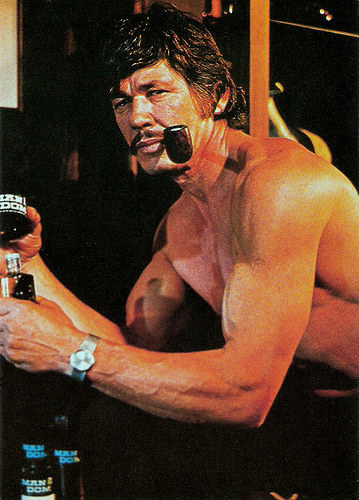
French postcard by Editions F. Nugeron, no. Stars 62. Photo: J. Ritchie.
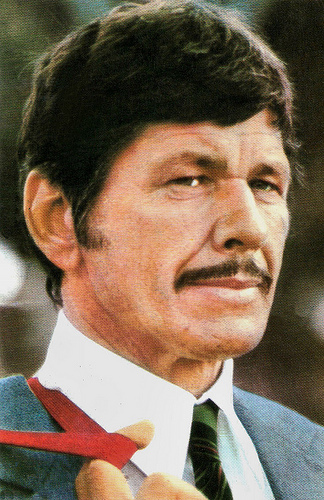
Romanian postcard by Casa Filmului Acin, 1971. Photo: publicity still for Le passager de la pluie/Rider on the Rain (René Clément, 1970).
A mysterious stranger with a harmonica, on a quest to get even
The 1960s proved to be the era in which Charles Bronson made his reputation as a man of few words but much action. Director John Sturges cast him in the smash hit Western The Magnificent Seven (John Sturges, 1960) with Yul Brynner, Steve McQueen and Horst Buchholz . He played half Irish/half Mexican gunslinger Bernardo O'Reilly, one of seven gunfighters taking up the cause of the defenseless. Several more strong roles followed.
Sturges hired him again for the WWII POW big-budget epic The Great Escape (John Sturges, 1963), starring Steve McQueen, James Garner and Richard Attenborough . Bronsons' expertise with tunnelling and working underground, dating from his years working in the mines, turned out to be quite helpful when playing the role of claustrophobic Polish prisoner of war, nicknamed 'Tunnel King', Danny Velinski.
During the filming of The Great Escape (1963), Bronson was introduced to actress Jill Ireland, by her then-husband David McCallum. They fell in love and married in 1968. Ireland became his frequent co-star in such later films as Le passager de la pluie/Rider On The Rain (René Clément, 1970) with Jill Ireland, and The Valachi Papers (Terence Young, 1972) with Lino Ventura .
Once again, Bronson was back in military uniform, now as an Army death row convict, in the testosterone-filled The Dirty Dozen (Robert Aldrich, 1967). During World War II, a rebellious U.S. Army Major (Lee Marvin) is assigned a dozen military prisoners with death sentences or long terms to train and lead them into a suicide mission: a mass assassination mission of German officers. It was a massive box office success but Bronson was only the third lead. He seemed unable to make the transition to star of major studio films in Hollywood.
European audiences had taken a shine to his minimalist acting style. Alain Delon ;was looking for an American actor to play his co-star in Adieu l’ami/Farewell, Friend (Jean Herman, 1968). He admired Bronson's acting, particularly in films like Machine Gun Kelly and had the producer approach him. Bronson headed to the France to appear in Adieu l’ami/Farewell, Friend. The film was a massive hit in France, earning around $6 million at the box office. It was crucial to Charles Bronson's career, making him a European film star, after being pigeonholed as a supporting actor in Hollywood.
Bronson then played his best role in the classic Spaghetti Western C'era una volta il West/Once Upon a Time in the West (Sergio Leone, 1968). He was Harmoniac, a mysterious stranger with a harmonica, on a quest to get even. He joins forces with a notorious desperado (Jason Robards) to protect a beautiful widow ( Claudia Cardinale ) from a ruthless assassin (Henry Fonda) working for the railroad. Director Sergio Leone later called him "the greatest actor I ever worked with". Lucia Bozzola at AllMovie : "As in his "Dollars" trilogy, Leone transforms the standard Western plot through the visual impact of wide screen landscapes and the figures therein. At its full length, Once Upon a Time in the West is Leone's operatic masterwork, worthy of its legend-making title."
Now, Bronson had made a serious name for himself in European films, and starred in such action-oriented films as La bataille de San Sebastian/Guns for San Sebastian (Henri Verneuil, 1968), and the Western Soleil rouge/Red Sun (Terence Young, 1971) alongside Japanese screen legend Toshirô Mifune and Ursula Andress . In Britain, he was cast in the lead of Lola (Richard Donner, 1969), playing a middle-aged man in love with a 16-year-old girl (Susan George). He also made a buddy comedy with Tony Curtisand Michèle Mercier in Turkey, You Can't Win 'Em All (Peter Collinson, 1970).
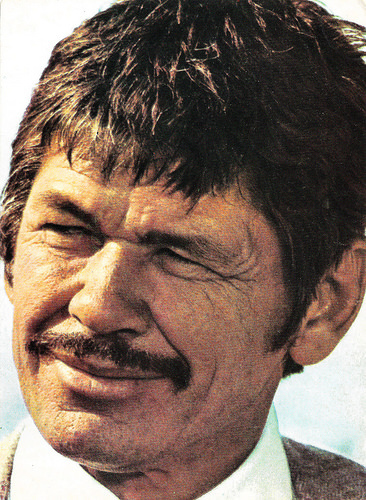
Romanian postcard by Casa Filmului ACIN.
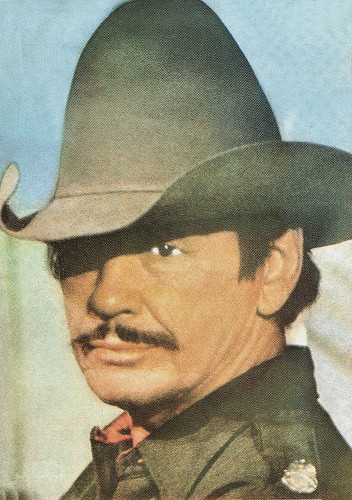
Romanian postcard by Casa Filmului Acin, 1971. Photo: publicity still for Borderline (Jerrold Freedman, 1980).
An overnight sensation in the USA after 25 years
Charles Bronson returned to Hollywood in the early 1970s to take the lead in the revenge Western Chato's Land (Michael Winner, 1972) with Jack Palance. After nearly 25 years as a working actor, he became an 'overnight sensation'. Chato's Land started a string of successful urban crime thrillers with British director Michael Winner, including the crime film The Mechanic (Michael Winner, 1972) with Keenan Wynn, Jill Ireland, and Jan-Michael Vincent, and The Stone Killer (Michael Winner, 1973) with Martin Balsam. He then scored a solid hit as a Colorado melon farmer-done-wrong in the Elmore Leonard adaptation Mr. Majestyk (Richard Fleischer, 1974).
However, the film that proved to be a breakthrough for both Bronson and Winner was the controversial Death Wish (Michael Winner, 1974). IMDb : "The US was at the time in the midst of rising street crime, and audiences flocked to see a story about a mild-mannered architect who seeks revenge for the murder of his wife and rape of his daughter by gunning down hoods, rapists and killers on the streets of New York City. So popular was the film that it spawned four sequels over the next 20 years."
Bronson earned good reviews for his role as the Depression-era street fighter Chaney in the directorial debut of Walter Hill, Hard Times (Walter Hill, 1975). Chaney competes in illegal bare-knuckled boxing matches after forming a partnership with the garrulous hustler Speed, played by James Coburn. It was followed by the Western Breakheart Pass (Tom Gries, 1975) with Jill Ireland, the light-hearted romp From Noon Till Three (Frank Gilroy, 1976) and the Cold War thriller Telefon (Don Siegel, 1977) with Lee Remick.
Bronson remained busy throughout the 1980s, with most of his films taking a more violent tone. Bronson jolted many critics with his forceful work as murdered United Mine Workers leader Jock Yablonski in the TV movie Act of Vengeance (John Mackenzie, 1986) opposite Ellen Burstyn, and gave an interesting performance in The Indian Runner (Sean Penn, 1991) starring David Morse and Viggo Mortensen. He surprised many as compassionate newspaper editor Francis Church in the family film Yes Virginia, There Is a Santa Claus (Charles Jarrott, 1991).
Bronson's final film roles were as police commissioner Paul Fein in a well-received trio of crime/drama TV movies, Family of Cops (Ted Kotcheff, 1995), Breach of Faith: A Family of Cops II (David Greene, 1997) and Family of Cops III: Under Suspicion (Sheldon Larry, 1999), with Sebastian Spence as his son. He retired from acting after undergoing hip replacement surgery in 1998.
Jill Ireland had passed away in 1990. Charles Bronson remarried with Kim Weeks in 1998. Ill health began to take its toll. Bronson suffered from Alzheimer's disease for the last few years of his life. He finally passed away from pneumonia at Los Angeles' Cedars-Sinai Medical Center in 2003. He was 81. Bronson had two children, Tony and Suzanne, with his first wife, Harriet Tendler, and a child with Ireland, Zuleika. Bronson and Jill Ireland had adopted Katrina Holden Bronson after her mother Hilary Holden died in 1983. Their adopted son, Jason, died of an accidental drug overdose in 1989.
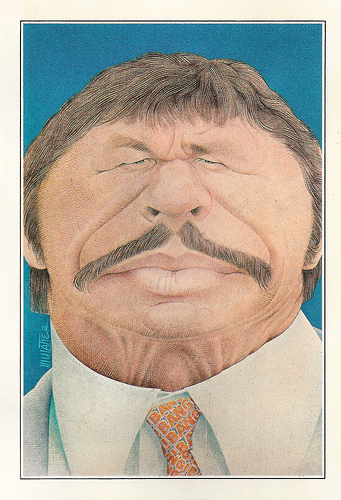
French postcard in the Les Grandes Gueules Series by Dervish International Publications, Paris, no. 116. Illustration: Mulatier - Ricord - Morchoisne.
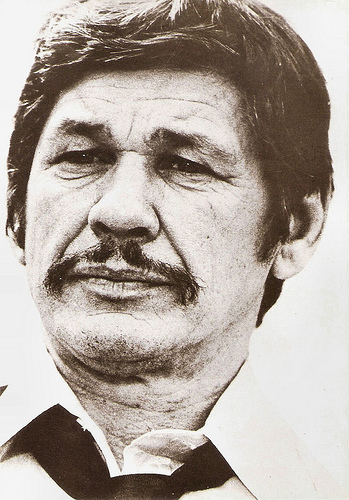
French postcard by Delta Productions, Montpellier, no. CP153.
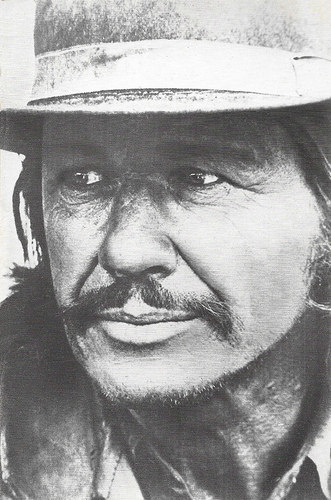
French postcard by Ebullitions, no. 37.
Source: Hal Erickson (AllMovie), Lucia Bozzola (AllMovie), Wikipedia and .

Italian postcard by Edizioni Beatrice d'Este, no. 20025. Photo: publicity still for Breakout (Tom Gries, 1975).

French postcard by Delta-Productions, Saint-Jean-de-Vedas, no. R53.

Italian postcard by Cineteca Bologna, 2007. Photo: A. Novi / Cineteca di Bologna. Publicity still for C'era una volta il West/Once Upon a Time in the West (Sergio Leone, 1968).
The mute and morbid assistant to Vincent Price
Charles Bronson was born Charles Dennis Buchinsky, in Ehrenfeld, Pennsylvania, in 1921. He was the 11th of 15 children of struggling Roman Catholic parents. His mother, Mary (Valinsky), was born in Pennsylvania, to Lithuanian parents, and his father, Walter Buchinsky, was a Lithuanian immigrant coal miner. The family had Lipka Tatar roots (Lipka Tatars were a group of Tatars who originally settled in the Grand Duchy of Lithuania at the beginning of the 14th century).
His father died when Charles was 10. He learned to speak English when he was a teenager; before that, he spoke Lithuanian and Russian. Charles completed high school, and at 16 he followed his brothers into the mines to support the family. He was paid $1 for each ton of coal that he mined and volunteered for perilous jobs because the pay was better.
Charles was drafted into the army in 1943 and assigned to the Air Corps. At first he was a truck driver, but was later trained as a bomber tail gunner and in 1945, he was assigned to a B-29. He flew 25 missions and received, among other decorations, a Purple Heart for wounds incurred in battle. After his return from the war, Bronson used the GI Bill to study art.
Bronson worked at many odd jobs. While working as a set designer for a Philadelphia theatre troupe, Bronson played a few small roles and almost immediately switched his allegiance from the production end of theatre to acting. In New York he shared an apartment with Jack Klugman while both were aspiring to play on the stage. In 1949, he moved to California, where he signed up for acting lessons at the Pasadena Playhouse. One of his teachers was impressed with the young man and recommended him to director Henry Hathaway, resulting in Bronson making his film debut in You're in the Navy Now (Henry Hathaway, 1951), with Gary Cooper.
Charles Buchinsky appeared on screen often early in his career, though usually uncredited. However, he made an impact on audiences as Igor, the mute and morbid assistant to deranged sculptor Vincent Price in the 3-D thriller House of Wax (Andre de Toth, 1953). In 1954, in the midst of the McCarthy 'Red Scare', he changed his stage name at the suggestion of his agent, who was fearful that his last name (Buchinsky) would damage his career. The name Bronson is said to be taken from the Bronson Gate at Paramount Studios, at the north end of Bronson Avenue.
His sinewy yet muscular physique got him cast in action-type roles, often without a shirt to highlight his manly frame. Bronson had a notable support part as an Indian in Apache (1954) for director Robert Aldrich. Aldrich asked him again for the Western Vera Cruz (Robert Aldrich, 1954) with Gary Cooper and Burt Lancaster . Bronson received positive notices from critics for his performances in the Western Drum Beat (Delmer Daves, 1954) with Alan Ladd, Target Zero (Harmon Jones, 1955), and Run of the Arrow (Samuel Fuller, 1957) with Rod Steiger and Sara Montiel .
Bronson had his first lead role in Gang War (Gene Fowler Jr., 1958), an inexpensive second feature released by 20th Century-Fox for the drive-in crowd. He played an embryonic version of his later Death Wish persona as mild-mannered L.A. schoolteacher who embarks upon a one-man vendetta against the murderers of his pregnant wife.
Indie director Roger Corman then cast him as real life 1930s Public Enemy number 1, George 'Machine-Gun' Kelly, in the well-received low-budget biopic Machine-Gun Kelly (Roger Corman, 1958). Bronson next scored the lead in his own TV detective series, Man with a Camera (1958-1960) as a former combat cameraman, who is now a freelance photographer in New York City, specialising in difficult and dangerous assignments.

French postcard by Editions F. Nugeron, no. Stars 62. Photo: J. Ritchie.

Romanian postcard by Casa Filmului Acin, 1971. Photo: publicity still for Le passager de la pluie/Rider on the Rain (René Clément, 1970).
A mysterious stranger with a harmonica, on a quest to get even
The 1960s proved to be the era in which Charles Bronson made his reputation as a man of few words but much action. Director John Sturges cast him in the smash hit Western The Magnificent Seven (John Sturges, 1960) with Yul Brynner, Steve McQueen and Horst Buchholz . He played half Irish/half Mexican gunslinger Bernardo O'Reilly, one of seven gunfighters taking up the cause of the defenseless. Several more strong roles followed.
Sturges hired him again for the WWII POW big-budget epic The Great Escape (John Sturges, 1963), starring Steve McQueen, James Garner and Richard Attenborough . Bronsons' expertise with tunnelling and working underground, dating from his years working in the mines, turned out to be quite helpful when playing the role of claustrophobic Polish prisoner of war, nicknamed 'Tunnel King', Danny Velinski.
During the filming of The Great Escape (1963), Bronson was introduced to actress Jill Ireland, by her then-husband David McCallum. They fell in love and married in 1968. Ireland became his frequent co-star in such later films as Le passager de la pluie/Rider On The Rain (René Clément, 1970) with Jill Ireland, and The Valachi Papers (Terence Young, 1972) with Lino Ventura .
Once again, Bronson was back in military uniform, now as an Army death row convict, in the testosterone-filled The Dirty Dozen (Robert Aldrich, 1967). During World War II, a rebellious U.S. Army Major (Lee Marvin) is assigned a dozen military prisoners with death sentences or long terms to train and lead them into a suicide mission: a mass assassination mission of German officers. It was a massive box office success but Bronson was only the third lead. He seemed unable to make the transition to star of major studio films in Hollywood.
European audiences had taken a shine to his minimalist acting style. Alain Delon ;was looking for an American actor to play his co-star in Adieu l’ami/Farewell, Friend (Jean Herman, 1968). He admired Bronson's acting, particularly in films like Machine Gun Kelly and had the producer approach him. Bronson headed to the France to appear in Adieu l’ami/Farewell, Friend. The film was a massive hit in France, earning around $6 million at the box office. It was crucial to Charles Bronson's career, making him a European film star, after being pigeonholed as a supporting actor in Hollywood.
Bronson then played his best role in the classic Spaghetti Western C'era una volta il West/Once Upon a Time in the West (Sergio Leone, 1968). He was Harmoniac, a mysterious stranger with a harmonica, on a quest to get even. He joins forces with a notorious desperado (Jason Robards) to protect a beautiful widow ( Claudia Cardinale ) from a ruthless assassin (Henry Fonda) working for the railroad. Director Sergio Leone later called him "the greatest actor I ever worked with". Lucia Bozzola at AllMovie : "As in his "Dollars" trilogy, Leone transforms the standard Western plot through the visual impact of wide screen landscapes and the figures therein. At its full length, Once Upon a Time in the West is Leone's operatic masterwork, worthy of its legend-making title."
Now, Bronson had made a serious name for himself in European films, and starred in such action-oriented films as La bataille de San Sebastian/Guns for San Sebastian (Henri Verneuil, 1968), and the Western Soleil rouge/Red Sun (Terence Young, 1971) alongside Japanese screen legend Toshirô Mifune and Ursula Andress . In Britain, he was cast in the lead of Lola (Richard Donner, 1969), playing a middle-aged man in love with a 16-year-old girl (Susan George). He also made a buddy comedy with Tony Curtisand Michèle Mercier in Turkey, You Can't Win 'Em All (Peter Collinson, 1970).

Romanian postcard by Casa Filmului ACIN.

Romanian postcard by Casa Filmului Acin, 1971. Photo: publicity still for Borderline (Jerrold Freedman, 1980).
An overnight sensation in the USA after 25 years
Charles Bronson returned to Hollywood in the early 1970s to take the lead in the revenge Western Chato's Land (Michael Winner, 1972) with Jack Palance. After nearly 25 years as a working actor, he became an 'overnight sensation'. Chato's Land started a string of successful urban crime thrillers with British director Michael Winner, including the crime film The Mechanic (Michael Winner, 1972) with Keenan Wynn, Jill Ireland, and Jan-Michael Vincent, and The Stone Killer (Michael Winner, 1973) with Martin Balsam. He then scored a solid hit as a Colorado melon farmer-done-wrong in the Elmore Leonard adaptation Mr. Majestyk (Richard Fleischer, 1974).
However, the film that proved to be a breakthrough for both Bronson and Winner was the controversial Death Wish (Michael Winner, 1974). IMDb : "The US was at the time in the midst of rising street crime, and audiences flocked to see a story about a mild-mannered architect who seeks revenge for the murder of his wife and rape of his daughter by gunning down hoods, rapists and killers on the streets of New York City. So popular was the film that it spawned four sequels over the next 20 years."
Bronson earned good reviews for his role as the Depression-era street fighter Chaney in the directorial debut of Walter Hill, Hard Times (Walter Hill, 1975). Chaney competes in illegal bare-knuckled boxing matches after forming a partnership with the garrulous hustler Speed, played by James Coburn. It was followed by the Western Breakheart Pass (Tom Gries, 1975) with Jill Ireland, the light-hearted romp From Noon Till Three (Frank Gilroy, 1976) and the Cold War thriller Telefon (Don Siegel, 1977) with Lee Remick.
Bronson remained busy throughout the 1980s, with most of his films taking a more violent tone. Bronson jolted many critics with his forceful work as murdered United Mine Workers leader Jock Yablonski in the TV movie Act of Vengeance (John Mackenzie, 1986) opposite Ellen Burstyn, and gave an interesting performance in The Indian Runner (Sean Penn, 1991) starring David Morse and Viggo Mortensen. He surprised many as compassionate newspaper editor Francis Church in the family film Yes Virginia, There Is a Santa Claus (Charles Jarrott, 1991).
Bronson's final film roles were as police commissioner Paul Fein in a well-received trio of crime/drama TV movies, Family of Cops (Ted Kotcheff, 1995), Breach of Faith: A Family of Cops II (David Greene, 1997) and Family of Cops III: Under Suspicion (Sheldon Larry, 1999), with Sebastian Spence as his son. He retired from acting after undergoing hip replacement surgery in 1998.
Jill Ireland had passed away in 1990. Charles Bronson remarried with Kim Weeks in 1998. Ill health began to take its toll. Bronson suffered from Alzheimer's disease for the last few years of his life. He finally passed away from pneumonia at Los Angeles' Cedars-Sinai Medical Center in 2003. He was 81. Bronson had two children, Tony and Suzanne, with his first wife, Harriet Tendler, and a child with Ireland, Zuleika. Bronson and Jill Ireland had adopted Katrina Holden Bronson after her mother Hilary Holden died in 1983. Their adopted son, Jason, died of an accidental drug overdose in 1989.

French postcard in the Les Grandes Gueules Series by Dervish International Publications, Paris, no. 116. Illustration: Mulatier - Ricord - Morchoisne.

French postcard by Delta Productions, Montpellier, no. CP153.

French postcard by Ebullitions, no. 37.
Source: Hal Erickson (AllMovie), Lucia Bozzola (AllMovie), Wikipedia and .
Published on January 26, 2019 22:00
January 25, 2019
Photo by Cines
Cines was the first major Italian film studio. Filoteo Alberini and Dante Santoni founded the studio in 1905 as ‘Alberini & Santoni’, then changed it in 1906 to the public corporation ‘Società italiana Cines’. Cines focused on the historical film genre, with the epic Quo vadis? (1913) as one of the highlights, but also pioneered with the Spaghetti Western. The studio stopped to exist in 1956.
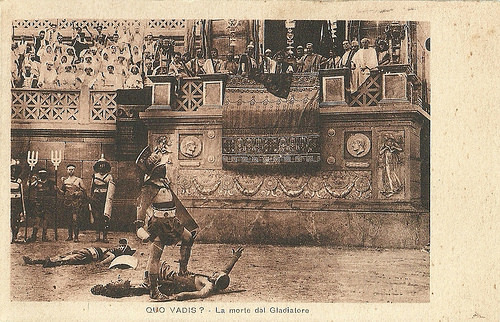
Italian postcard. Photo: Cines. Publicity still for the early epic Quo vadis? (Enrico Guazzoni, 1913), adapted from Henryk Sienkiewicz's classic novel and the biggest film hit of 1913 worldwide. Caption: The death of the gladiator. This image cites Jean-Léon Gérôme's famous painting Pollice verso (Thumbs down, 1872) and was often used in the publicity for the film. In the back the emperor Nero (Carlo Cattaneo) makes the sign of thumbs down, sign for the conqueror to kill his adversary. Flanking Nero are left Tigellinus (Cesare Moltroni) and right Petronius ( Gustavo Serena ). Left of the imperial box the Vestal Virgins are seated.
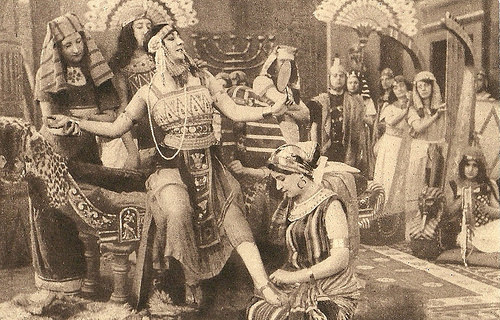
German postcard by BKWI, no. 34. Photo: Cines. Publicity still for the Italian silent epic Marcantonio e Cleopatra/Anthony and Cleopatra (Enrico Guazzoni, 1913). Here Cleopatra (Gianna Terribili Gonzales) is enjoying herself.
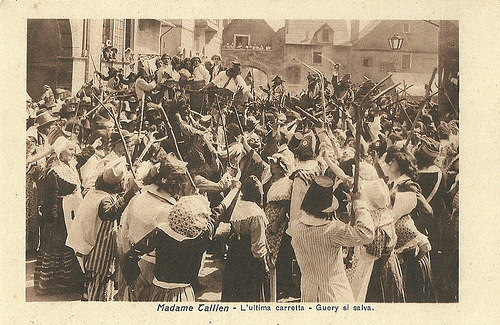
Italian postcard by IPA CT Duplex. Photo: Film Cines, no. 3279. Ruggero Barni as Jean Guery in the silent film Madame Tallien (Mario Caserini, Enrico Guazzoni, 1916) based on the play by Victorien Sardou. The caption goes: The last cart. Guery is saved.
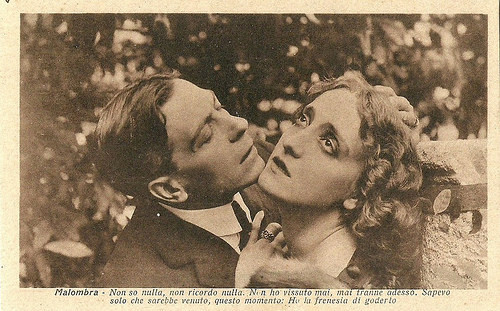
Italian postcard by IPA CT Duplex. Photo: Film Cines. Publicity still for the silent film Malombra (Carmine Gallone, 1917), adapted from the novel by Antonio Fogazzaro, and starring Amleto Novelli and Lyda Borelli . Caption: I don't know nothing, I remember nothing. I never lived, never apart from now. I knew only you would come, this moment. I have the frenzy to enjoy it.
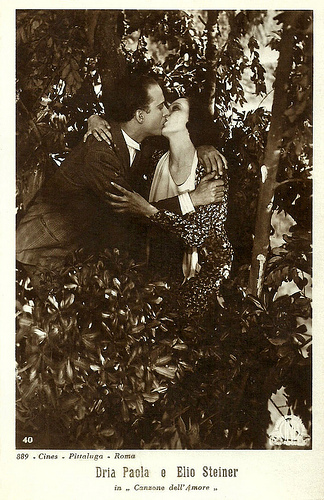
Italian postcard by G.B. Falci, Milano, no. 889. Photo: Cines-Pittaluga, Rome. Lucia ( Dria Paola ) and Enrico (Elio Steiner) hide from their friends in order to be able to kiss each other, in the first Italian sound film La canzone dell’amore (1930) by Gennaro Righelli.
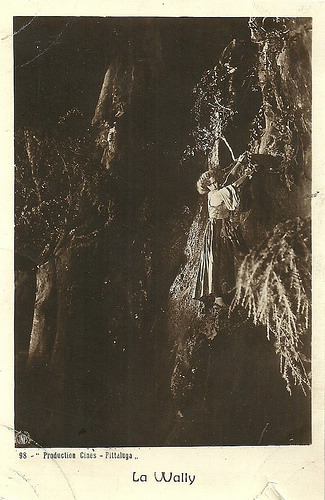
Italian postcard, no. 98. Photo: Cines-Pittaluga. Publicity still for La Wally (Guido Brignone 1932), starring Germana Paolieri .
Modern utilities and a fixed cast
In 1905 the first major Italian film studio was founded by Filoteo Alberini and Dante Santoni as ‘Alberoni & Santoni’, then changed in 1906 to the public corporation ‘Società italiana Cines’.
Aberini had opened Rome's first cinema, the Cinema Moderno on 20 January 1904, while in 1899 he had opened a film theatre in Florence, Italy. He also had patented an invention for filming, printing and developing, as early as 1895. In 1911, he created the Autostereoscopio (stereoscopic device), followed by the Panoramica Alberini, a primitive wide-screen technique.
In 1905 Alberini & Santoni produced La presa di Roma/The Taking of Rome, a prototype for the Italian historical film shot in a studio and using trained actors. In 1906 the management of Cines lured the French filmmaker Gaston Velle away from Pathé and he produced a series of féeries.
In 1907 former actor Mario Caserini started as director. From then on, Cines started to focus on the genre of historical films in which the company excelled. Around 1910 a pupil of Caserini, the former painter and art director Enrico Guazzoni, started to discern himself as the director of historical productions such as Brutus (1910), Agrippina (1910), and La sposa del Nilo/The Bride of the Nile (1910) with Bruto Castellani and Fernanda Negri Pouget .
In the same period (1909-1910), Cines was confronted with the crisis in the world film industry caused by overproduction. Count Alberto Fassini was ordered to liquidate the company, but reorganised it instead. He attracted several aristocrats in the board and provided an enormous increase of capital.
From then on the company could guarantee a steady production. The studio became equipped with modern utilities and was populated by a fixed cast, including Amleto Novelli , Maria Caserini-Gasperini, Gianna Terribili Gonzales, and crew with long-term contracts, which contemporarily worked on different productions. A script office was installed for the regular output of scenarios. Cines was the first Italian company to produce its own raw film stock, which stimulated the development of the company.
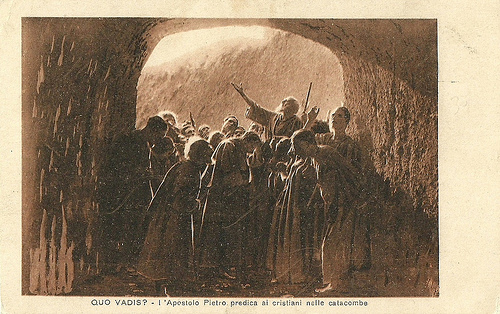
Italian postcard. Photo: Cines. Publicity still for the popular early epic Quo vadis? (Enrico Guazzoni, 1913), adapted from Henryk Sienkiewicz's classic novel. Caption: The apostle Peter preaching to the Christians in the catacombs.
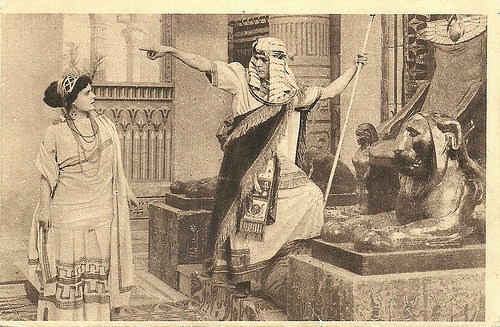
German postcard by BKWI, no. 35. Photo: Cines. Publicity still for the Italian silent epic Marcantonio e Cleopatra (Enrico Guazzoni, 1913). Here Marc Anthony ( Amleto Novelli ), dressed as Egyptian pharao, rejects his wife Octavia (Elsa Lenard).
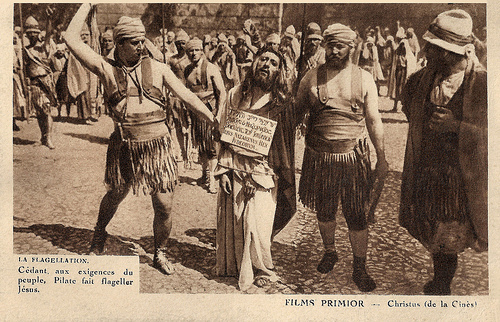
French postcard by Films Primior, Paris / J. Meyer, Paris. Photo: Cines. Publicity still for Christus/Christ (Giulio Antamoro and, uncredited, Enrico Guazzoni, 1916). Caption: The Flagellation. Bowing to the demands of the people, Pilate flogged Jesus. Apart from the famous Nativity and early childhood episodes, the film presents the adult Christ ( Alberto Pasquali ) going back to Egypt and 'testing', his skills as an orator and miracle-maker on the natives under the shadow of their Sphinx-shaped pyramids. Liberties are also taken with the chronology of Jesus' ministry – with the Devil's temptation in the desert, for example, taking place before His Baptism. The character of Judas (Augusto Mastripietri) is naturally given his space during the Passion segments but, what makes his scenes interesting, is that the figure of a horned devil thrice appears to him as a hallucination – when he betrays Jesus to the High Priests, when he repents of his deed and when he hangs himself in desperation. Christus also depicts the events following the Passion i.e. the Resurrection, the Doubting Thomas episode and the Ascension.
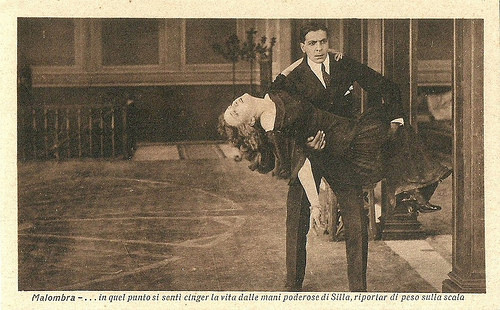
Italian postcard by IPA CT Duplex. Photo: Film Cines. Publicity still for Malombra (Carmine Gallone, 1917), adapted from the novel by Antonio Fogazzaro, and starring Lyda Borelli and Amleto Novelli . Caption: Caption: ...at that moment she felt her waist held by the powerful hands of Silla, who lifted her back up the stairs.
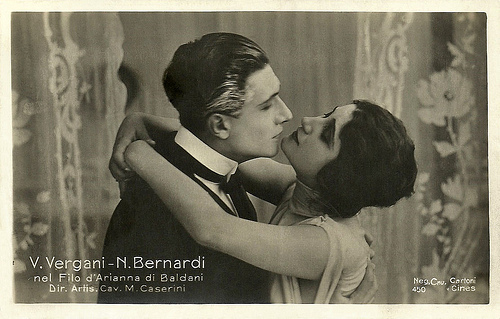
Italian postcard, no. 450. Photo: Cines. Vera Vergani and Nerio Bernardi in the Italian silent film Il filo d'Arianna (Mario Caserini, 1921).
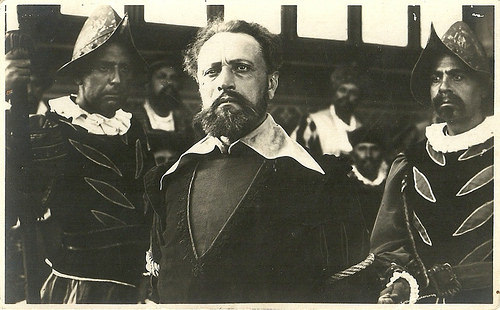
Italian postcard by G.B. Falci, Milano. Photo: Cines/UCI. Publicity still for the period piece Triboulet (Febo Mari, 1923), with Achille Vitti as king Francis I of France, Umberto Zanuccoli in the title role and Elena Sangro as Giletta.
Thrilling audiences all over the world
The historical production was brought to a climax with the epic Quo vadis?, produced in 1912 but released in 1913. The large three-dimensional sets, the reviving of the ‘grandeur’ of Roman antiquity, the many extras and the spectacular scenes such as the burning of Rome and the Roman arena, thrilled audiences all over the world. Quo vadis? (Enrico Guazzoni, 1913), starring Amleto Novelli and Gustavo Serena , not only put Cines among the first of the world’s film companies, but also contributed much to the acceptance of cinema as an art form and form of ‘respectable’ entertainment.
Quo Vadis?’ success caused the production of two other big budget epics set in Antique times, Marcantonio e Cleopatra/Anthony and Cleopatra (Enrico Guazzoni, 1913) with Gianna Terribili-Gonzales and Amleto Novelli , and Cajus Julius Caesar/Julius Caesar (Enrico Guazzoni, 1914) with Amleto Novelli and Bruto Castellani .
Next to historical films, Cines was well-known for its steady output of comedies, both farces with Tontolini (Ferdinando Guillaume) and Kri Kri (Raymond Frau) as more boulevardier-like comedies as Una tragedia al cinematografo/A Tragedy at the Cinematograph (Enrico Guazzoni, 1913), in which Pina Menichelli had one of her first roles. Cines had a steady output of modern dramas, in which future diva Francesca Bertini excelled after her roles in historical films at Film d’Arte Italiana and before going over to Celio, a daughter-company of Cines.
Cines produced many non-fiction films. These were moreover travelogues, glorifying the beauties of natural scenery, mainly in Italy itself. Cines even produced the first Italian Westerns, preceding the later Spaghetti Westerns of the 1960s and 1970s.
After the outbreak of the First World War, Cines survived the fall caused by the war by releasing films with stars as Lyda Borelli and by employing a new generation of outstanding directors such as Nino Oxilia, Giulio Antamoro, Carmine Gallone, Augusto Genina and Amleto Palermi.
The decline was unstoppable however. In 1919, Cines merged with the Unione Cinematografica Italiana and stopped activity in 1923. Production was retaken however in the years 1930-1934, when Cines made the first Italian sound film, La canzone dell’amore/The Song of Love (Gennaro Righelli, 1930), but a fire destroyed the studio. Cines was resurrected in 1941-1944 and again in 1949-1956. Most early Cines films are to be found nowadays in the film archives of London, Amsterdam and Bologna.
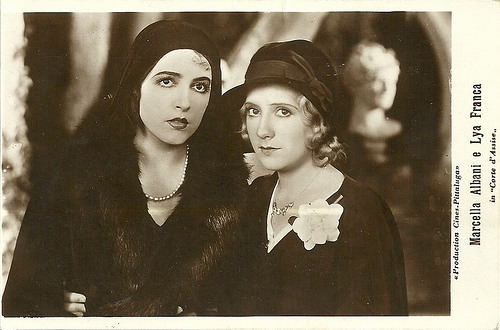
Italian postcard. Photo: Produzione Cines-Pittaluga. Publicity still of Marcella Albani and Lya Franca in the courtcase melodrama Corte d'Assise/Before the Jury (Guido Brignone, 1931).
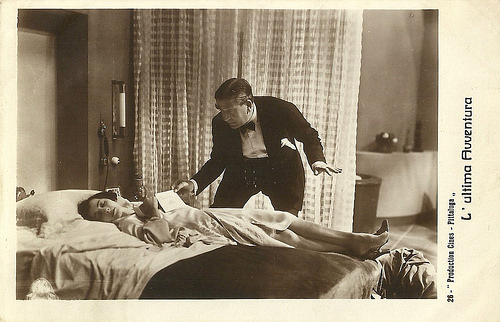
Italian postcard, even if with French written captions, no. 26. Photo: Cines-Pittaluga. Publicity still for the early Italian sound film L'ultima avventura/The Last Adventure (Mario Camerini, 1932) with Diomira Jacobini and Armando Falconi.
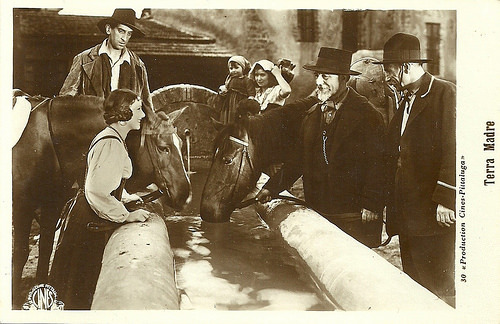
Italian postcard, no. 30. Photo: Produzione Cines-Pittaluga. Leda Gloria had the female lead in the rural drama Terra madre/Earth mother (1931) by Alessandro Blasetti.
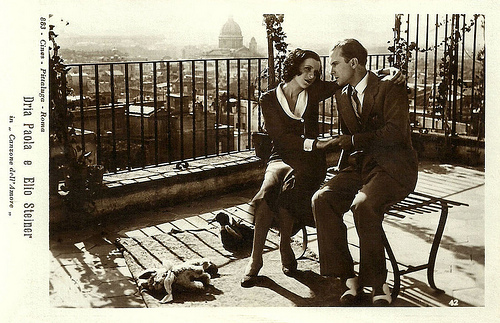
Italian postcard by G.B. Falci, Milano, no. 40. Photo: Cines-Pittaluga. After an attempted suicide, Lucia ( Dria Paola ) and Enrico (Elio Steiner) make up towards the end of La canzone dell’amore/The song of love (Gennaro Righelli, 1930). The cityscape of Rome in the background.
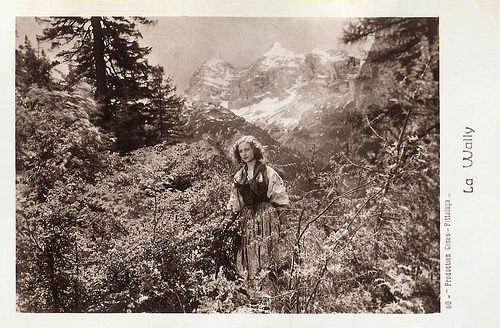
Italian postcard by G.B. Falci, Milano, no. 60. Photo: Cines-Pittaluga. Publicity still for La Wally (Guido Brignone, 1932), starring Germana Paolieri as Wally.
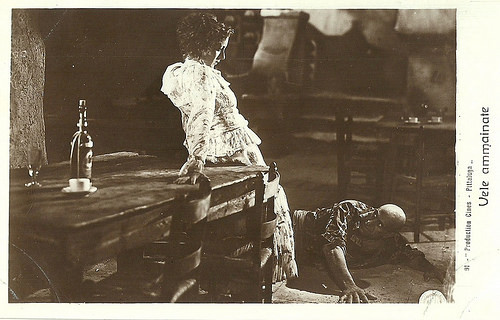
Italian postcard by G.B. Falci, Milano, no. 91. Photo: Cines-Pattulaga. Publicity still for Vele ammainate/Lowered Sails (Anton Giulio Bragaglia, 1931) with Dria Paola .
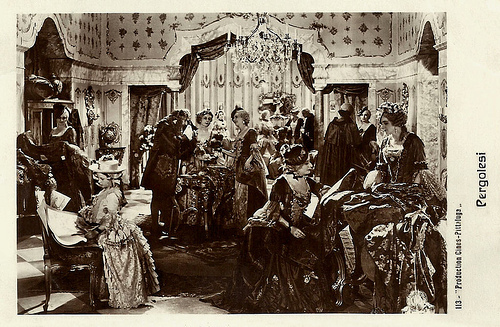
Italian postcard by G.B. Falci, Milano, no. 113. Photo: Cines-Pattulaga. The wealth of the upperclass in Pergolesi (Guido Brignone, 1932), starring Dria Paola , Elio Steiner and Livio Pavanelli . This was the debut of costume designer Gino Sensani.
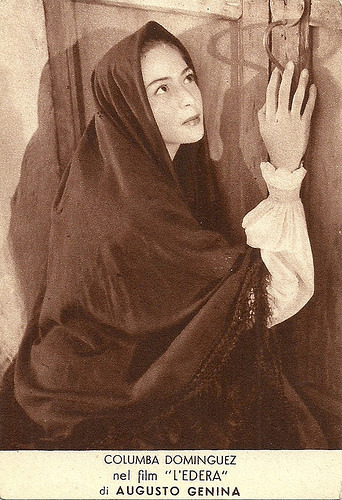
Columba Dominguez. Italian postcard by Ed. Mondadori. Photo: Cines / ENIC / AGAR. Publicity still for L'edera/Devotion (Augusto Genina, 1950).
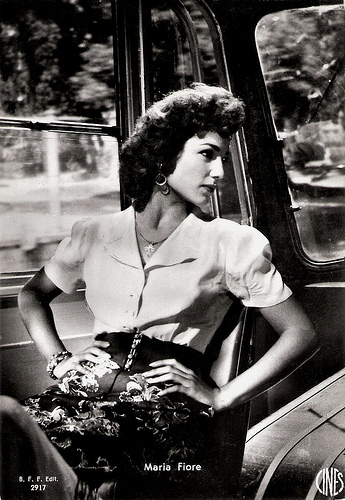
Maria Fiore . Italian postcard by B.F.F. Edit., Firenze, no 2917. Photo: Cines. Publicity still for Tempi nostri - Zibaldone n. 2/A Slice of Life (Alessandro Blasetti, Paul Paviot, 1954).
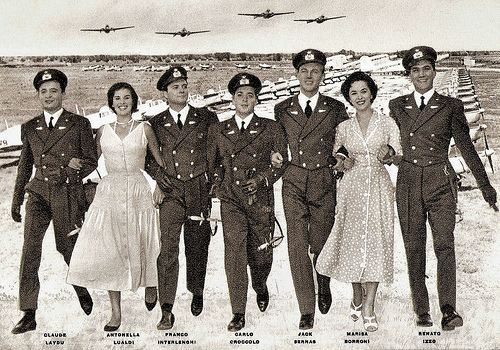
Claude Laydu, Antonella Lualdi, Franco Interlenghi , Jacques Sernas and others. Italian postcard by La Rotografica Romana. Photo: Cines / ENIC. Publicity still for Altair (Leonardo De Mitri, 1956).
Sources: Paolo Bertetto and Gianni Rondolino (Cabiria e il suo tempo - Italian), Ivo Blom (Encyclopedia of Early Cinema) and .

Italian postcard. Photo: Cines. Publicity still for the early epic Quo vadis? (Enrico Guazzoni, 1913), adapted from Henryk Sienkiewicz's classic novel and the biggest film hit of 1913 worldwide. Caption: The death of the gladiator. This image cites Jean-Léon Gérôme's famous painting Pollice verso (Thumbs down, 1872) and was often used in the publicity for the film. In the back the emperor Nero (Carlo Cattaneo) makes the sign of thumbs down, sign for the conqueror to kill his adversary. Flanking Nero are left Tigellinus (Cesare Moltroni) and right Petronius ( Gustavo Serena ). Left of the imperial box the Vestal Virgins are seated.

German postcard by BKWI, no. 34. Photo: Cines. Publicity still for the Italian silent epic Marcantonio e Cleopatra/Anthony and Cleopatra (Enrico Guazzoni, 1913). Here Cleopatra (Gianna Terribili Gonzales) is enjoying herself.

Italian postcard by IPA CT Duplex. Photo: Film Cines, no. 3279. Ruggero Barni as Jean Guery in the silent film Madame Tallien (Mario Caserini, Enrico Guazzoni, 1916) based on the play by Victorien Sardou. The caption goes: The last cart. Guery is saved.

Italian postcard by IPA CT Duplex. Photo: Film Cines. Publicity still for the silent film Malombra (Carmine Gallone, 1917), adapted from the novel by Antonio Fogazzaro, and starring Amleto Novelli and Lyda Borelli . Caption: I don't know nothing, I remember nothing. I never lived, never apart from now. I knew only you would come, this moment. I have the frenzy to enjoy it.

Italian postcard by G.B. Falci, Milano, no. 889. Photo: Cines-Pittaluga, Rome. Lucia ( Dria Paola ) and Enrico (Elio Steiner) hide from their friends in order to be able to kiss each other, in the first Italian sound film La canzone dell’amore (1930) by Gennaro Righelli.

Italian postcard, no. 98. Photo: Cines-Pittaluga. Publicity still for La Wally (Guido Brignone 1932), starring Germana Paolieri .
Modern utilities and a fixed cast
In 1905 the first major Italian film studio was founded by Filoteo Alberini and Dante Santoni as ‘Alberoni & Santoni’, then changed in 1906 to the public corporation ‘Società italiana Cines’.
Aberini had opened Rome's first cinema, the Cinema Moderno on 20 January 1904, while in 1899 he had opened a film theatre in Florence, Italy. He also had patented an invention for filming, printing and developing, as early as 1895. In 1911, he created the Autostereoscopio (stereoscopic device), followed by the Panoramica Alberini, a primitive wide-screen technique.
In 1905 Alberini & Santoni produced La presa di Roma/The Taking of Rome, a prototype for the Italian historical film shot in a studio and using trained actors. In 1906 the management of Cines lured the French filmmaker Gaston Velle away from Pathé and he produced a series of féeries.
In 1907 former actor Mario Caserini started as director. From then on, Cines started to focus on the genre of historical films in which the company excelled. Around 1910 a pupil of Caserini, the former painter and art director Enrico Guazzoni, started to discern himself as the director of historical productions such as Brutus (1910), Agrippina (1910), and La sposa del Nilo/The Bride of the Nile (1910) with Bruto Castellani and Fernanda Negri Pouget .
In the same period (1909-1910), Cines was confronted with the crisis in the world film industry caused by overproduction. Count Alberto Fassini was ordered to liquidate the company, but reorganised it instead. He attracted several aristocrats in the board and provided an enormous increase of capital.
From then on the company could guarantee a steady production. The studio became equipped with modern utilities and was populated by a fixed cast, including Amleto Novelli , Maria Caserini-Gasperini, Gianna Terribili Gonzales, and crew with long-term contracts, which contemporarily worked on different productions. A script office was installed for the regular output of scenarios. Cines was the first Italian company to produce its own raw film stock, which stimulated the development of the company.

Italian postcard. Photo: Cines. Publicity still for the popular early epic Quo vadis? (Enrico Guazzoni, 1913), adapted from Henryk Sienkiewicz's classic novel. Caption: The apostle Peter preaching to the Christians in the catacombs.

German postcard by BKWI, no. 35. Photo: Cines. Publicity still for the Italian silent epic Marcantonio e Cleopatra (Enrico Guazzoni, 1913). Here Marc Anthony ( Amleto Novelli ), dressed as Egyptian pharao, rejects his wife Octavia (Elsa Lenard).

French postcard by Films Primior, Paris / J. Meyer, Paris. Photo: Cines. Publicity still for Christus/Christ (Giulio Antamoro and, uncredited, Enrico Guazzoni, 1916). Caption: The Flagellation. Bowing to the demands of the people, Pilate flogged Jesus. Apart from the famous Nativity and early childhood episodes, the film presents the adult Christ ( Alberto Pasquali ) going back to Egypt and 'testing', his skills as an orator and miracle-maker on the natives under the shadow of their Sphinx-shaped pyramids. Liberties are also taken with the chronology of Jesus' ministry – with the Devil's temptation in the desert, for example, taking place before His Baptism. The character of Judas (Augusto Mastripietri) is naturally given his space during the Passion segments but, what makes his scenes interesting, is that the figure of a horned devil thrice appears to him as a hallucination – when he betrays Jesus to the High Priests, when he repents of his deed and when he hangs himself in desperation. Christus also depicts the events following the Passion i.e. the Resurrection, the Doubting Thomas episode and the Ascension.

Italian postcard by IPA CT Duplex. Photo: Film Cines. Publicity still for Malombra (Carmine Gallone, 1917), adapted from the novel by Antonio Fogazzaro, and starring Lyda Borelli and Amleto Novelli . Caption: Caption: ...at that moment she felt her waist held by the powerful hands of Silla, who lifted her back up the stairs.

Italian postcard, no. 450. Photo: Cines. Vera Vergani and Nerio Bernardi in the Italian silent film Il filo d'Arianna (Mario Caserini, 1921).

Italian postcard by G.B. Falci, Milano. Photo: Cines/UCI. Publicity still for the period piece Triboulet (Febo Mari, 1923), with Achille Vitti as king Francis I of France, Umberto Zanuccoli in the title role and Elena Sangro as Giletta.
Thrilling audiences all over the world
The historical production was brought to a climax with the epic Quo vadis?, produced in 1912 but released in 1913. The large three-dimensional sets, the reviving of the ‘grandeur’ of Roman antiquity, the many extras and the spectacular scenes such as the burning of Rome and the Roman arena, thrilled audiences all over the world. Quo vadis? (Enrico Guazzoni, 1913), starring Amleto Novelli and Gustavo Serena , not only put Cines among the first of the world’s film companies, but also contributed much to the acceptance of cinema as an art form and form of ‘respectable’ entertainment.
Quo Vadis?’ success caused the production of two other big budget epics set in Antique times, Marcantonio e Cleopatra/Anthony and Cleopatra (Enrico Guazzoni, 1913) with Gianna Terribili-Gonzales and Amleto Novelli , and Cajus Julius Caesar/Julius Caesar (Enrico Guazzoni, 1914) with Amleto Novelli and Bruto Castellani .
Next to historical films, Cines was well-known for its steady output of comedies, both farces with Tontolini (Ferdinando Guillaume) and Kri Kri (Raymond Frau) as more boulevardier-like comedies as Una tragedia al cinematografo/A Tragedy at the Cinematograph (Enrico Guazzoni, 1913), in which Pina Menichelli had one of her first roles. Cines had a steady output of modern dramas, in which future diva Francesca Bertini excelled after her roles in historical films at Film d’Arte Italiana and before going over to Celio, a daughter-company of Cines.
Cines produced many non-fiction films. These were moreover travelogues, glorifying the beauties of natural scenery, mainly in Italy itself. Cines even produced the first Italian Westerns, preceding the later Spaghetti Westerns of the 1960s and 1970s.
After the outbreak of the First World War, Cines survived the fall caused by the war by releasing films with stars as Lyda Borelli and by employing a new generation of outstanding directors such as Nino Oxilia, Giulio Antamoro, Carmine Gallone, Augusto Genina and Amleto Palermi.
The decline was unstoppable however. In 1919, Cines merged with the Unione Cinematografica Italiana and stopped activity in 1923. Production was retaken however in the years 1930-1934, when Cines made the first Italian sound film, La canzone dell’amore/The Song of Love (Gennaro Righelli, 1930), but a fire destroyed the studio. Cines was resurrected in 1941-1944 and again in 1949-1956. Most early Cines films are to be found nowadays in the film archives of London, Amsterdam and Bologna.

Italian postcard. Photo: Produzione Cines-Pittaluga. Publicity still of Marcella Albani and Lya Franca in the courtcase melodrama Corte d'Assise/Before the Jury (Guido Brignone, 1931).

Italian postcard, even if with French written captions, no. 26. Photo: Cines-Pittaluga. Publicity still for the early Italian sound film L'ultima avventura/The Last Adventure (Mario Camerini, 1932) with Diomira Jacobini and Armando Falconi.

Italian postcard, no. 30. Photo: Produzione Cines-Pittaluga. Leda Gloria had the female lead in the rural drama Terra madre/Earth mother (1931) by Alessandro Blasetti.

Italian postcard by G.B. Falci, Milano, no. 40. Photo: Cines-Pittaluga. After an attempted suicide, Lucia ( Dria Paola ) and Enrico (Elio Steiner) make up towards the end of La canzone dell’amore/The song of love (Gennaro Righelli, 1930). The cityscape of Rome in the background.

Italian postcard by G.B. Falci, Milano, no. 60. Photo: Cines-Pittaluga. Publicity still for La Wally (Guido Brignone, 1932), starring Germana Paolieri as Wally.

Italian postcard by G.B. Falci, Milano, no. 91. Photo: Cines-Pattulaga. Publicity still for Vele ammainate/Lowered Sails (Anton Giulio Bragaglia, 1931) with Dria Paola .

Italian postcard by G.B. Falci, Milano, no. 113. Photo: Cines-Pattulaga. The wealth of the upperclass in Pergolesi (Guido Brignone, 1932), starring Dria Paola , Elio Steiner and Livio Pavanelli . This was the debut of costume designer Gino Sensani.

Columba Dominguez. Italian postcard by Ed. Mondadori. Photo: Cines / ENIC / AGAR. Publicity still for L'edera/Devotion (Augusto Genina, 1950).

Maria Fiore . Italian postcard by B.F.F. Edit., Firenze, no 2917. Photo: Cines. Publicity still for Tempi nostri - Zibaldone n. 2/A Slice of Life (Alessandro Blasetti, Paul Paviot, 1954).

Claude Laydu, Antonella Lualdi, Franco Interlenghi , Jacques Sernas and others. Italian postcard by La Rotografica Romana. Photo: Cines / ENIC. Publicity still for Altair (Leonardo De Mitri, 1956).
Sources: Paolo Bertetto and Gianni Rondolino (Cabiria e il suo tempo - Italian), Ivo Blom (Encyclopedia of Early Cinema) and .
Published on January 25, 2019 22:00
January 24, 2019
The Great Caruso (1951)
Mario Lanza's masterpiece was The Great Caruso (Richard Thorpe, 1951). His voice in the film was so dazzling that an awestruck Arturo Toscanini called it the "voice of the century". The Great Caruso became the top-grossing film in the world in 1951, but if you're looking for a serious biography of legendary tenor Enrico Caruso, this film ain't it.
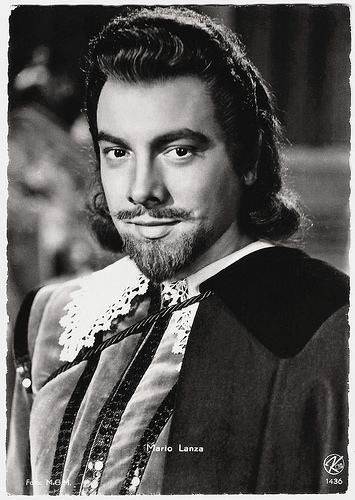
Austrian postcard by Kellner Fotokarten, Wien, no. 1436. Photo: MGM. Publicity still for The Great Caruso (Richard Thorpe, 1951).
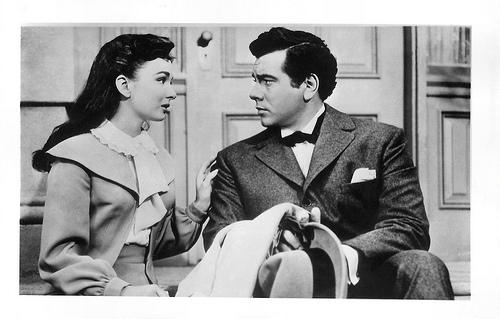
German photo-card. Photo: Metro-Goldwyn-Mayer. Publicity still for The Great Caruso (Richard Thorpe, 1951) with Mario Lanza and Ann Blyth.
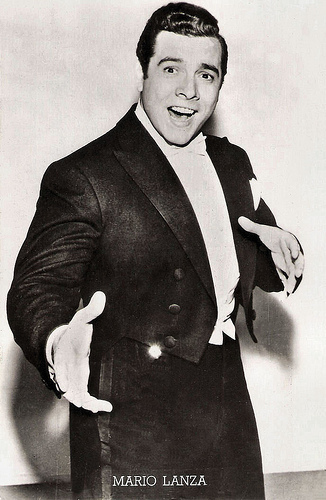
Belgian postcard, no. 452. Photo: MGM. Publicity still for The Great Caruso (Richard Thorpe, 1951).
Short, barrel chested, loud, emotional, unrefined
The highly fictionalised The Great Caruso (Richard Thorpe, 1951) traces the life of Italian tenor Enrico Caruso (1873-1921). In his home town of Naples, the young Enrico (played with charm by Peter Edward Price) grows into an enterprising young man who realises his voice is potentially his fortune. Enrico (Mario Lanza) loves Musetta (Yvette Duguay), but he is unacceptable to her father, because he sings. When he later performs in New York, Caruso falls in love with Dorothy (Ann Blyth), the daughter of one of the Metropolitan Opera's patrons. He is unacceptable to her father, because he is a peasant. To New York patricians, Caruso is short, barrel chested, loud, emotional, unrefined. Their appreciation comes slowly.
The film depicts Caruso's lament that "the man does not have the voice, the voice has the man": he cannot be places he wants to be, because he must be elsewhere singing, including the day his mother dies. The film also stars Ann Blyth, Dorothy Kirsten, Eduard Franz and Ludwig Donath. Ann Blyth is lovely as Dorothy and gets to sing a little herself. And Mario Lanza's acting is natural and genuine.
Throughout the film, The Great Caruso (1951) stars from the Metropolitan Opera sing and the film offers some beautifully staged operatic arias. The music is glorious and beautifully sung by Lanza, Dorothy Kirsten, Jarmila Novotná , Blanche Thebom, Giuseppe Valdengo, and other top-notch opera stars.
Mario Lanza himself helped popularise The Great Caruso (1951) with an RCA Red Seal album of songs from the film. He sings the music in The Great Caruso with a robust energy; he is truly here at the peak of what would be a short career. His versions of 'Ave Maria', 'Cielo e Mar', 'E Lucevan le stelle', and especially his superb 'Vesti la Giubba' are spectacular. In all the film contains 27 vocal items, with not a dull moment to be found amongst them.
Enrico Caruso had been one of the pioneers of recorded music and had a long partnership with the Victor Talking-Machine Company (later RCA Victor). He was the first opera star to have his voice immortalised for all time.The Great Caruso (Richard Thorpe, 1951) won an Oscar for sound recording and received nominations for costume and set design.
Mario Lanza's larger than life personality and magnificent voice were never better served than here in The Great Caruso (1951). The film gives a taste of what Lanza might have become if he had had the discipline of a Caruso to stick to opera. The Great Caruso is a great film, and a tribute to two of the legendary voices of our time.
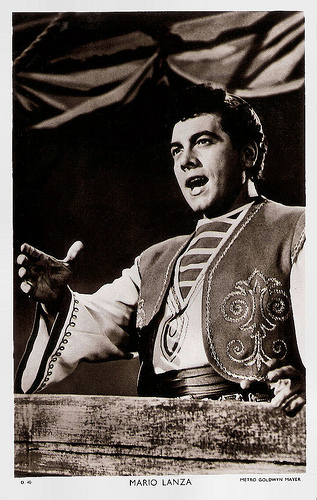
British postcard in the Picturegoer Series, London, no. D 40. Photo: Metro-Goldwyn-Mayer. Publicity still for The Great Caruso (Richard Thorpe, 1951).
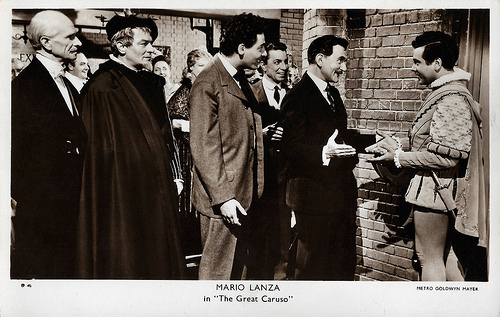
British postcard in the Picturegoer Series, London, no. D 46. Photo: Metro-Goldwyn-Mayer. Publicity still for The Great Caruso (Richard Thorpe, 1951).
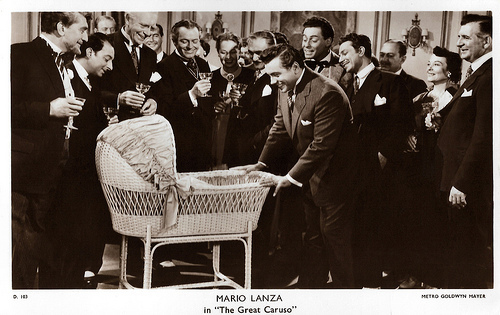
British postcard in the Picturegoer Series, London, no. D 103. Photo: Metro-Goldwyn-Mayer. Publicity still for The Great Caruso (Richard Thorpe, 1951).
Any similarities are purely coincidental...
The script of The Great Caruso (Richard Thorpe, 1951) was written by Sonya Levien and William Ludwig and 'suggested' by Dorothy Caruso's biography of her husband. The film opens with the hilarious credits: The events, characters and firms depicted in this photoplay are fictitious. Any similarity to actual persons, living or dead, or to actual firms is purely coincidental...
To say that liberties were taken with Enrico Caruso's life is to be modest. Caruso, like the man who portrayed him, was a man of large appetites although with a lot more self discipline. He had numerous relationships with several women and fathered two out of wedlock sons who are not in this film. Furthermore, his first role at the Metropolitan Opera was not Radames in 'Aida', as indicated in the film, but the Duke in 'Rigoletto'. Caruso also didn't die on stage during a performance of 'Martha' at the Metropolitan. He had a hemorrhage during 'L'Elisir d'amore' at the Met and could not finish the performance. He only sang three more times at the Met, his last role as Eleazar in 'La Juive'.
What is true is that Dorothy's father disowned her after her marriage, and left her $1 of his massive estate. They also did have a daughter Gloria together who died at the age of 79 in 2007. So the film bears little resemblance to the real Caruso's life, and is corny in the grand tradition of Hollywood musicals, but who cares?
A good, readable biography is Enrico Caruso Jr.'s 'Caruso: My Father and My Family'. In it, Caruso Jr. (half-brother of Gloria) compliments Mario Lanza for his performance in the film: "Mario Lanza was born with one of the dozen or so great tenor voices of the century, with a natural gift for placement, an unmistakable and very pleasing timbre, and a nearly infallible musical instinct conspicuously absent in the overwhelming majority of so-called 'great' singers. His diction was flawless, matched only by the superb Giuseppe di Stefano. His delivery was impassioned, his phrasing manly, and his tempi instinctively right -- qualities that few singers are born with and others can never attain. (...) I can think of no other tenor, before or since Mario Lanza, who could have risen with comparable success to the challenge of playing Caruso in a screen biography."
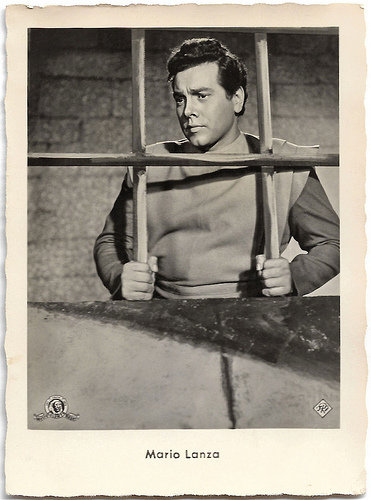
German collectors card by SR. Photo: Metro-Goldwyn-Mayer. Publicity still for The Great Caruso (Richard Thorpe, 1951).
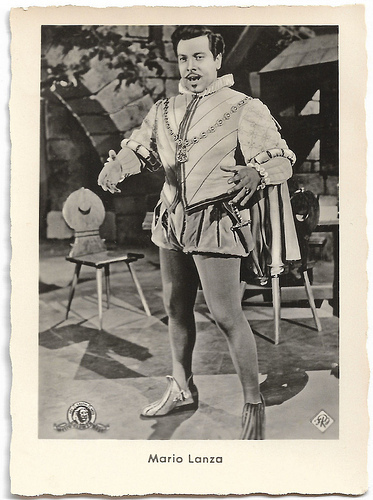
German collectors card by SR. Photo: Metro-Goldwyn-Mayer. Publicity still for The Great Caruso (Richard Thorpe, 1951).
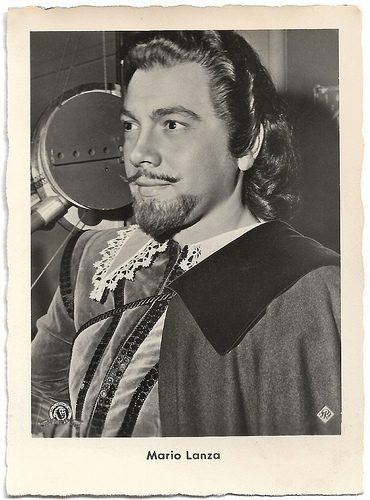
German collectors card by SR. Photo: Metro-Goldwyn-Mayer. Publicity still for The Great Caruso (Richard Thorpe, 1951).
Next Friday, we'll post a film special on Mario Lanza's film Because You're Mine (Alexander Hall, 1952).
Sources: Wikipedia and IMDb.

Austrian postcard by Kellner Fotokarten, Wien, no. 1436. Photo: MGM. Publicity still for The Great Caruso (Richard Thorpe, 1951).

German photo-card. Photo: Metro-Goldwyn-Mayer. Publicity still for The Great Caruso (Richard Thorpe, 1951) with Mario Lanza and Ann Blyth.

Belgian postcard, no. 452. Photo: MGM. Publicity still for The Great Caruso (Richard Thorpe, 1951).
Short, barrel chested, loud, emotional, unrefined
The highly fictionalised The Great Caruso (Richard Thorpe, 1951) traces the life of Italian tenor Enrico Caruso (1873-1921). In his home town of Naples, the young Enrico (played with charm by Peter Edward Price) grows into an enterprising young man who realises his voice is potentially his fortune. Enrico (Mario Lanza) loves Musetta (Yvette Duguay), but he is unacceptable to her father, because he sings. When he later performs in New York, Caruso falls in love with Dorothy (Ann Blyth), the daughter of one of the Metropolitan Opera's patrons. He is unacceptable to her father, because he is a peasant. To New York patricians, Caruso is short, barrel chested, loud, emotional, unrefined. Their appreciation comes slowly.
The film depicts Caruso's lament that "the man does not have the voice, the voice has the man": he cannot be places he wants to be, because he must be elsewhere singing, including the day his mother dies. The film also stars Ann Blyth, Dorothy Kirsten, Eduard Franz and Ludwig Donath. Ann Blyth is lovely as Dorothy and gets to sing a little herself. And Mario Lanza's acting is natural and genuine.
Throughout the film, The Great Caruso (1951) stars from the Metropolitan Opera sing and the film offers some beautifully staged operatic arias. The music is glorious and beautifully sung by Lanza, Dorothy Kirsten, Jarmila Novotná , Blanche Thebom, Giuseppe Valdengo, and other top-notch opera stars.
Mario Lanza himself helped popularise The Great Caruso (1951) with an RCA Red Seal album of songs from the film. He sings the music in The Great Caruso with a robust energy; he is truly here at the peak of what would be a short career. His versions of 'Ave Maria', 'Cielo e Mar', 'E Lucevan le stelle', and especially his superb 'Vesti la Giubba' are spectacular. In all the film contains 27 vocal items, with not a dull moment to be found amongst them.
Enrico Caruso had been one of the pioneers of recorded music and had a long partnership with the Victor Talking-Machine Company (later RCA Victor). He was the first opera star to have his voice immortalised for all time.The Great Caruso (Richard Thorpe, 1951) won an Oscar for sound recording and received nominations for costume and set design.
Mario Lanza's larger than life personality and magnificent voice were never better served than here in The Great Caruso (1951). The film gives a taste of what Lanza might have become if he had had the discipline of a Caruso to stick to opera. The Great Caruso is a great film, and a tribute to two of the legendary voices of our time.

British postcard in the Picturegoer Series, London, no. D 40. Photo: Metro-Goldwyn-Mayer. Publicity still for The Great Caruso (Richard Thorpe, 1951).

British postcard in the Picturegoer Series, London, no. D 46. Photo: Metro-Goldwyn-Mayer. Publicity still for The Great Caruso (Richard Thorpe, 1951).

British postcard in the Picturegoer Series, London, no. D 103. Photo: Metro-Goldwyn-Mayer. Publicity still for The Great Caruso (Richard Thorpe, 1951).
Any similarities are purely coincidental...
The script of The Great Caruso (Richard Thorpe, 1951) was written by Sonya Levien and William Ludwig and 'suggested' by Dorothy Caruso's biography of her husband. The film opens with the hilarious credits: The events, characters and firms depicted in this photoplay are fictitious. Any similarity to actual persons, living or dead, or to actual firms is purely coincidental...
To say that liberties were taken with Enrico Caruso's life is to be modest. Caruso, like the man who portrayed him, was a man of large appetites although with a lot more self discipline. He had numerous relationships with several women and fathered two out of wedlock sons who are not in this film. Furthermore, his first role at the Metropolitan Opera was not Radames in 'Aida', as indicated in the film, but the Duke in 'Rigoletto'. Caruso also didn't die on stage during a performance of 'Martha' at the Metropolitan. He had a hemorrhage during 'L'Elisir d'amore' at the Met and could not finish the performance. He only sang three more times at the Met, his last role as Eleazar in 'La Juive'.
What is true is that Dorothy's father disowned her after her marriage, and left her $1 of his massive estate. They also did have a daughter Gloria together who died at the age of 79 in 2007. So the film bears little resemblance to the real Caruso's life, and is corny in the grand tradition of Hollywood musicals, but who cares?
A good, readable biography is Enrico Caruso Jr.'s 'Caruso: My Father and My Family'. In it, Caruso Jr. (half-brother of Gloria) compliments Mario Lanza for his performance in the film: "Mario Lanza was born with one of the dozen or so great tenor voices of the century, with a natural gift for placement, an unmistakable and very pleasing timbre, and a nearly infallible musical instinct conspicuously absent in the overwhelming majority of so-called 'great' singers. His diction was flawless, matched only by the superb Giuseppe di Stefano. His delivery was impassioned, his phrasing manly, and his tempi instinctively right -- qualities that few singers are born with and others can never attain. (...) I can think of no other tenor, before or since Mario Lanza, who could have risen with comparable success to the challenge of playing Caruso in a screen biography."

German collectors card by SR. Photo: Metro-Goldwyn-Mayer. Publicity still for The Great Caruso (Richard Thorpe, 1951).

German collectors card by SR. Photo: Metro-Goldwyn-Mayer. Publicity still for The Great Caruso (Richard Thorpe, 1951).

German collectors card by SR. Photo: Metro-Goldwyn-Mayer. Publicity still for The Great Caruso (Richard Thorpe, 1951).
Next Friday, we'll post a film special on Mario Lanza's film Because You're Mine (Alexander Hall, 1952).
Sources: Wikipedia and IMDb.
Published on January 24, 2019 22:00
January 23, 2019
Muriel Pavlow (1921-2019)
British actress Muriel Pavlow passed away on 19 January 2019. The charming, delicate Pavlow was the quintessential English girl of many British films of the 1950s. She was usually cast as an unselfish bride, wife or girlfriend in thrillers and war films. In several light comedies she provided a nice counterbalance to the hectic goings-on. And, despite her small build, she was also a dominant stage actress. Muriel Pavlow was 97.

Big Italian card by Bromofoto, Milano. Photo: Rank. Publicity still for Doctor at Large (Ralph Thomas, 1957).
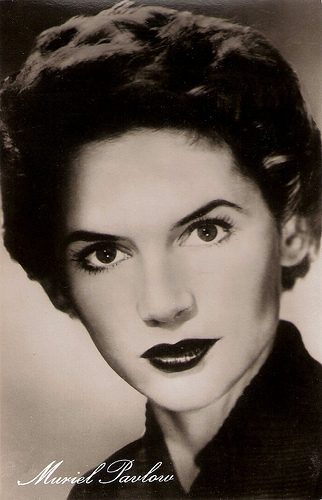
East-German postcard by VEB Progress Film-Vertrieb, Berlin, no. 1067, 1959. Photo: Rank / Progress.
Sprightly Teen Roles
Muriel Lilian Pavlow was born in Leigh, England in 1921. She had a Russian-born father and French mother.
She made her stage debut at age 15 with silent film star Lillian Gish in a production of The Old Maid (1936) by Zoe Aitkens. Other teen roles on stage included 'Oedipus Rex' (1936) with John Gielgud , 'Dear Octopus' (1938), and 'Dear Brutus' (1940).
At 13, Muriel had started out in the cinema with a bit role in the Gracie Fields musical comedy Sing As We Go (Basil Dean, 1934), and in 1937 she appeared in Romance in Flanders (Maurice Elvey, 1937), but she wouldn't come into her own for nearly two decades.
She often played ingénue roles much younger than her actual age, as in Quiet Wedding (Anthony Asquith, 1941) starring Margaret Lockwood and Derek Farr. She had a more prominent role in the war-time film Night Boat to Dublin (Lawrence Huntington, 1946).
Muriel Pavlow also made a beguiling Ophelia on a live, early TV version of Hamlet (Basil Adams, 1947), but for the most part she tried to build up her theatrical credits.
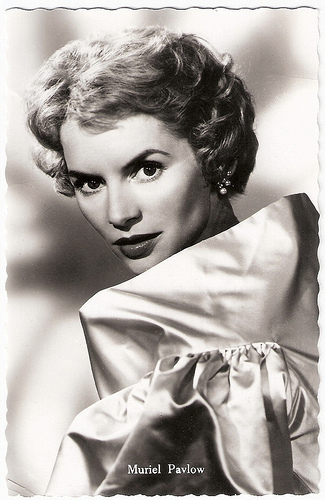
Dutch postcard, sent by mail in 1960, no. 115821. Photo: Rank. Publicity still for Rooney (George Pollock, 1958).
Peaking in the 1950s
In 1947 Muriel Pavlow married actor Derek Farr and went on to appear with him in such British-made films as The Shop at Sly Corner (George King, 1947) and Doctor at Large (Ralph Thomas, 1957).
Peaking in mid-1950s, she appeared as the Maltese girl Maria in Malta Story (Brian Desmond Hurst, 1953) with Alec Guinness , as Joy, the girlfriend of Simon Sparrow ( Dirk Bogarde ) in the first of the popular British ‘Doctor’ comedy series, Doctor in the House (Ralph Thomas, 1954), and as Thelma Bader, the wife of World War II fighter pilot Douglas Bader (Kenneth More) in Reach for the Sky (Lewis Gilbert, 1956).
She continued to perform in the theatre, notably in Shakespeare pieces, like 'A Midsummer Night's Dream', 'Othello, 'The Taming of the Shrew', and 'Troilus and Cressida'.
In the early 1960s she eased into character roles in films like the Agatha Christie adaptation Murder She Said (George Pollock, 1961). She and her husband worked for the most part on stage and television. The couple appeared together in such plays as 'Wolf's Clothing (1959) and 'Mary, Mary' (1963).
Following Farr's death in 1986, she resumed her career and was spotted in the late 1980s and 1990s in a number of matronly roles, such as in the TV-series Final Cut (Mike Vardy, 1995) starring Ian Richardson. One of her last roles was at age 83 in the TV-film Belonging (Christopher Menaul, 2004) in the company of Brenda Blethyn, Rosemary Harris and Anna Massey.
More recently she was interviewed by the BBC for the documentary series, 'British Film Forever' and in 2007, she guest-starred in the audio play Sapphire and Steel: Cruel Immortality.
In the cinema, she was last seen in Glorious 39 (Stephen Poliakoff, 2009), in which she had a cameo.

Italian postcard by Bromofoto, Milano, no. 1135. Photo: publicity still for Reach for the Sky (Lewis Gilbert, 1956).
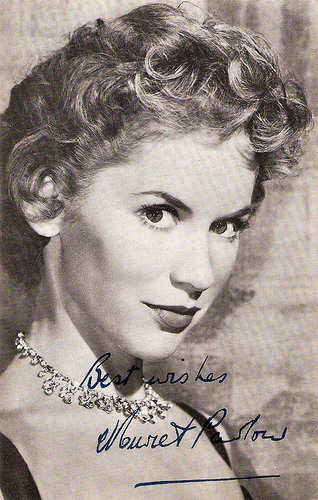
British postcard in the Celebrity Autograph series, no. 268. Photo: Rank. Publicity still for Doctor at Large (Ralph Thomas, 1957).
Sources: (IMDb), Hal Erickson (AllMovie), Ewan Jeffrey (Theatre Archive Project), Wikipedia, and .

Big Italian card by Bromofoto, Milano. Photo: Rank. Publicity still for Doctor at Large (Ralph Thomas, 1957).

East-German postcard by VEB Progress Film-Vertrieb, Berlin, no. 1067, 1959. Photo: Rank / Progress.
Sprightly Teen Roles
Muriel Lilian Pavlow was born in Leigh, England in 1921. She had a Russian-born father and French mother.
She made her stage debut at age 15 with silent film star Lillian Gish in a production of The Old Maid (1936) by Zoe Aitkens. Other teen roles on stage included 'Oedipus Rex' (1936) with John Gielgud , 'Dear Octopus' (1938), and 'Dear Brutus' (1940).
At 13, Muriel had started out in the cinema with a bit role in the Gracie Fields musical comedy Sing As We Go (Basil Dean, 1934), and in 1937 she appeared in Romance in Flanders (Maurice Elvey, 1937), but she wouldn't come into her own for nearly two decades.
She often played ingénue roles much younger than her actual age, as in Quiet Wedding (Anthony Asquith, 1941) starring Margaret Lockwood and Derek Farr. She had a more prominent role in the war-time film Night Boat to Dublin (Lawrence Huntington, 1946).
Muriel Pavlow also made a beguiling Ophelia on a live, early TV version of Hamlet (Basil Adams, 1947), but for the most part she tried to build up her theatrical credits.

Dutch postcard, sent by mail in 1960, no. 115821. Photo: Rank. Publicity still for Rooney (George Pollock, 1958).
Peaking in the 1950s
In 1947 Muriel Pavlow married actor Derek Farr and went on to appear with him in such British-made films as The Shop at Sly Corner (George King, 1947) and Doctor at Large (Ralph Thomas, 1957).
Peaking in mid-1950s, she appeared as the Maltese girl Maria in Malta Story (Brian Desmond Hurst, 1953) with Alec Guinness , as Joy, the girlfriend of Simon Sparrow ( Dirk Bogarde ) in the first of the popular British ‘Doctor’ comedy series, Doctor in the House (Ralph Thomas, 1954), and as Thelma Bader, the wife of World War II fighter pilot Douglas Bader (Kenneth More) in Reach for the Sky (Lewis Gilbert, 1956).
She continued to perform in the theatre, notably in Shakespeare pieces, like 'A Midsummer Night's Dream', 'Othello, 'The Taming of the Shrew', and 'Troilus and Cressida'.
In the early 1960s she eased into character roles in films like the Agatha Christie adaptation Murder She Said (George Pollock, 1961). She and her husband worked for the most part on stage and television. The couple appeared together in such plays as 'Wolf's Clothing (1959) and 'Mary, Mary' (1963).
Following Farr's death in 1986, she resumed her career and was spotted in the late 1980s and 1990s in a number of matronly roles, such as in the TV-series Final Cut (Mike Vardy, 1995) starring Ian Richardson. One of her last roles was at age 83 in the TV-film Belonging (Christopher Menaul, 2004) in the company of Brenda Blethyn, Rosemary Harris and Anna Massey.
More recently she was interviewed by the BBC for the documentary series, 'British Film Forever' and in 2007, she guest-starred in the audio play Sapphire and Steel: Cruel Immortality.
In the cinema, she was last seen in Glorious 39 (Stephen Poliakoff, 2009), in which she had a cameo.

Italian postcard by Bromofoto, Milano, no. 1135. Photo: publicity still for Reach for the Sky (Lewis Gilbert, 1956).

British postcard in the Celebrity Autograph series, no. 268. Photo: Rank. Publicity still for Doctor at Large (Ralph Thomas, 1957).
Sources: (IMDb), Hal Erickson (AllMovie), Ewan Jeffrey (Theatre Archive Project), Wikipedia, and .
Published on January 23, 2019 22:00
January 22, 2019
The Invisible Man (1933)
The Invisible Man (James Whale, 1933) is one of the best films of the early Universal horror series of the 1930s. The script, based on H.G. Wells science fiction classic, is solid and tight, and James Whale's direction is creative and technically excellent. Debutant Claude Rains plays the scientist who has developed a serum which turned himself invisible, and into a raving, mad megalomaniac. Whale laces his special humour throughout the film, and The Invisible Man is full of dark comedic moments.
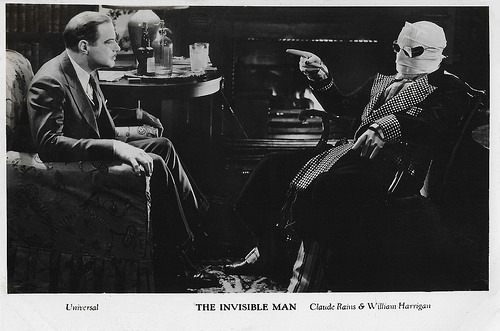
British postcard in the Filmshots series by Film Weekly. Photo: Universal. Publicity still for The Invisible Man (James Whale, 1933) with William Harrigan and Claude Rains .
A megalomaniac bent on conquering mankind and the world
A snow storm is blowing ferociously, a man trundles towards a signpost that reads Iping. When he enters a hostel called The Lions Head, the patrons of the bar fall silent for the man is bound in bandages.
He tells, not asks, the landlady; "I want a room with a fire". This man is Dr. Jack Griffin ( Claude Rains ), soon to be known as The Invisible Man. Director James Whale starts his classic horror fantasy The Invisible Man (1933) in a gripping style.
Working in Dr. Cranley's (Henry Travers) laboratory, Griffin was always given the latitude to conduct some of his own experiments. His sudden departure has Cranley's daughter Flora (Gloria Stuart) worried about him.
In his room in The Lions Head, Griffin hopes to reverse the experiment that made him invisible. Unfortunately, the drug he used has negative side effects, making him aggressive and dangerous.
Griffin is prepared to do whatever it takes to restore his appearance, and several people will die in the process. Finally the scientist has turned into a raving, mad megalomaniac bent on conquering mankind and the world.
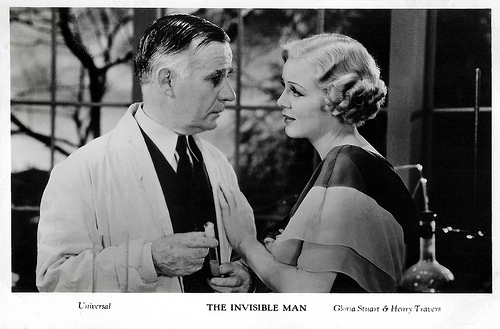
British postcard in the Filmshots series by Film Weekly. Photo: Universal. Publicity still for The Invisible Man (James Whale, 1933) with Henry Travers and Gloria Stuart.
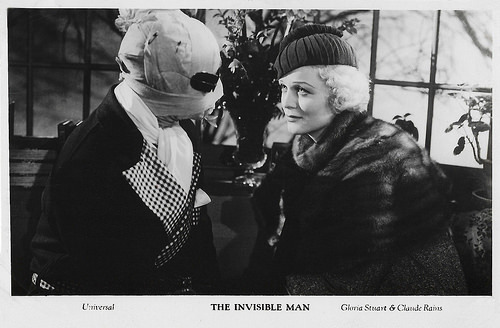
British postcard in the Filmshots series by Film Weekly. Photo: Universal. Publicity still for The Invisible Man (James Whale, 1933) with Claude Rains and Gloria Stuart.
Here I am...AREN'T YOU GLAD YOU FOUND ME?!!
The Invisible Man (James Whale, 1933) is filled with witty dialogue, excellent character acting, and a dazzling array of special effects. We get to see a shirt move on it's own, things fly around rooms and the invisible man causing mayhem.
What is most surprising about the film is its rather perverse sense of black humour (typical for Whale's films) and its cruelty. When a woman runs screaming down the lane at night followed by an empty pair of pants skipping along reciting "here we go gathering nuts in May", it is a funny tongue-in-cheek moment.
More darkly is the scene during a massive search for Griffin, after he causes a train disaster. One of the volunteers, slightly apart from the others, is grabbed and thrown down and choked. Griffin says, "Here I am...AREN'T YOU GLAD YOU FOUND ME?!!" It is a chilling moment.
The Invisible Man is not a benign horror monster but rather a frightening, destructive force capable of acts of violence, madness, and viciousness. Inventively, Whale combines script, acting, mood, and setting amidst the background of ground-breaking special effects that are still impressive to this day.
For Claude Rains , it was his first major film role. He spends much of the film either under the cover of bandages or not even in it. At the end of the film, he finally appears for a minute - as a corpse! But it doesn't matter because it's his voice that makes the performance and the role was for Rains his big break. The fiendishness of his voice is compelling and pure evil.
Baron Bl00d at IMDb : "The acting all around is very good with people like Henry Travers, Gloria Stuart, Una O'Connor and William Harrigan especially as a jealous doctor giving all the support they can to a formless Claude Rains . Rains's voice is magnificent and one senses he was made to play the part that would make him famous. Look also for Dwight Frye in a small role. A wonderful film experience!"

British postcard in the Filmshots series by Film Weekly. Photo: Universal. Publicity still for The Invisible Man (James Whale, 1933) with Gloria Stuart (and Claude Rains ).
The scene with the invisible man terrorising the village. Source: Movieclips (YouTube)
Sources: Baron Bl00d (IMDb), Wikipedia and IMDb.

British postcard in the Filmshots series by Film Weekly. Photo: Universal. Publicity still for The Invisible Man (James Whale, 1933) with William Harrigan and Claude Rains .
A megalomaniac bent on conquering mankind and the world
A snow storm is blowing ferociously, a man trundles towards a signpost that reads Iping. When he enters a hostel called The Lions Head, the patrons of the bar fall silent for the man is bound in bandages.
He tells, not asks, the landlady; "I want a room with a fire". This man is Dr. Jack Griffin ( Claude Rains ), soon to be known as The Invisible Man. Director James Whale starts his classic horror fantasy The Invisible Man (1933) in a gripping style.
Working in Dr. Cranley's (Henry Travers) laboratory, Griffin was always given the latitude to conduct some of his own experiments. His sudden departure has Cranley's daughter Flora (Gloria Stuart) worried about him.
In his room in The Lions Head, Griffin hopes to reverse the experiment that made him invisible. Unfortunately, the drug he used has negative side effects, making him aggressive and dangerous.
Griffin is prepared to do whatever it takes to restore his appearance, and several people will die in the process. Finally the scientist has turned into a raving, mad megalomaniac bent on conquering mankind and the world.

British postcard in the Filmshots series by Film Weekly. Photo: Universal. Publicity still for The Invisible Man (James Whale, 1933) with Henry Travers and Gloria Stuart.

British postcard in the Filmshots series by Film Weekly. Photo: Universal. Publicity still for The Invisible Man (James Whale, 1933) with Claude Rains and Gloria Stuart.
Here I am...AREN'T YOU GLAD YOU FOUND ME?!!
The Invisible Man (James Whale, 1933) is filled with witty dialogue, excellent character acting, and a dazzling array of special effects. We get to see a shirt move on it's own, things fly around rooms and the invisible man causing mayhem.
What is most surprising about the film is its rather perverse sense of black humour (typical for Whale's films) and its cruelty. When a woman runs screaming down the lane at night followed by an empty pair of pants skipping along reciting "here we go gathering nuts in May", it is a funny tongue-in-cheek moment.
More darkly is the scene during a massive search for Griffin, after he causes a train disaster. One of the volunteers, slightly apart from the others, is grabbed and thrown down and choked. Griffin says, "Here I am...AREN'T YOU GLAD YOU FOUND ME?!!" It is a chilling moment.
The Invisible Man is not a benign horror monster but rather a frightening, destructive force capable of acts of violence, madness, and viciousness. Inventively, Whale combines script, acting, mood, and setting amidst the background of ground-breaking special effects that are still impressive to this day.
For Claude Rains , it was his first major film role. He spends much of the film either under the cover of bandages or not even in it. At the end of the film, he finally appears for a minute - as a corpse! But it doesn't matter because it's his voice that makes the performance and the role was for Rains his big break. The fiendishness of his voice is compelling and pure evil.
Baron Bl00d at IMDb : "The acting all around is very good with people like Henry Travers, Gloria Stuart, Una O'Connor and William Harrigan especially as a jealous doctor giving all the support they can to a formless Claude Rains . Rains's voice is magnificent and one senses he was made to play the part that would make him famous. Look also for Dwight Frye in a small role. A wonderful film experience!"

British postcard in the Filmshots series by Film Weekly. Photo: Universal. Publicity still for The Invisible Man (James Whale, 1933) with Gloria Stuart (and Claude Rains ).
The scene with the invisible man terrorising the village. Source: Movieclips (YouTube)
Sources: Baron Bl00d (IMDb), Wikipedia and IMDb.
Published on January 22, 2019 22:00
Paul van Yperen's Blog
- Paul van Yperen's profile
- 13 followers
Paul van Yperen isn't a Goodreads Author
(yet),
but they
do have a blog,
so here are some recent posts imported from
their feed.



